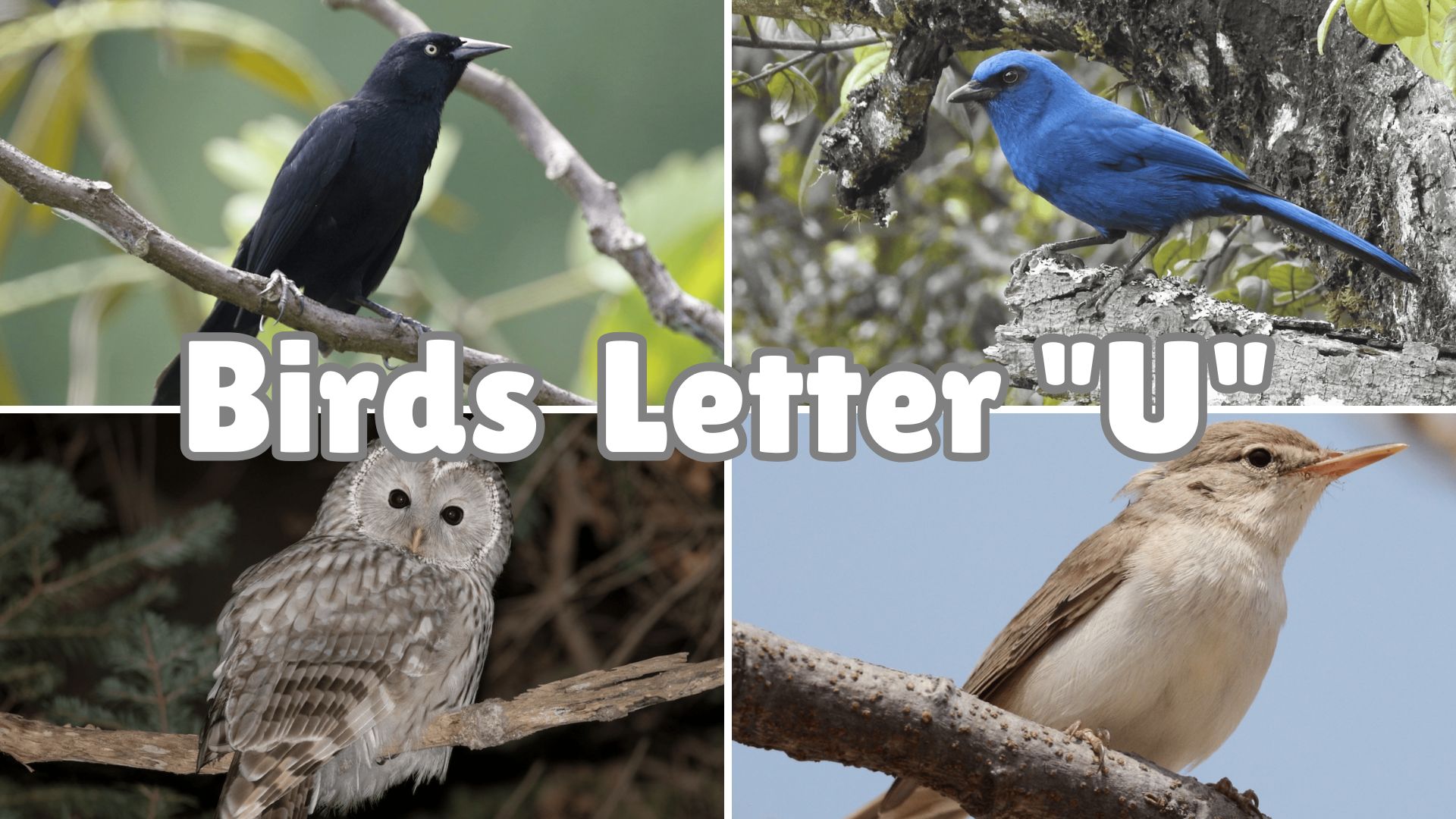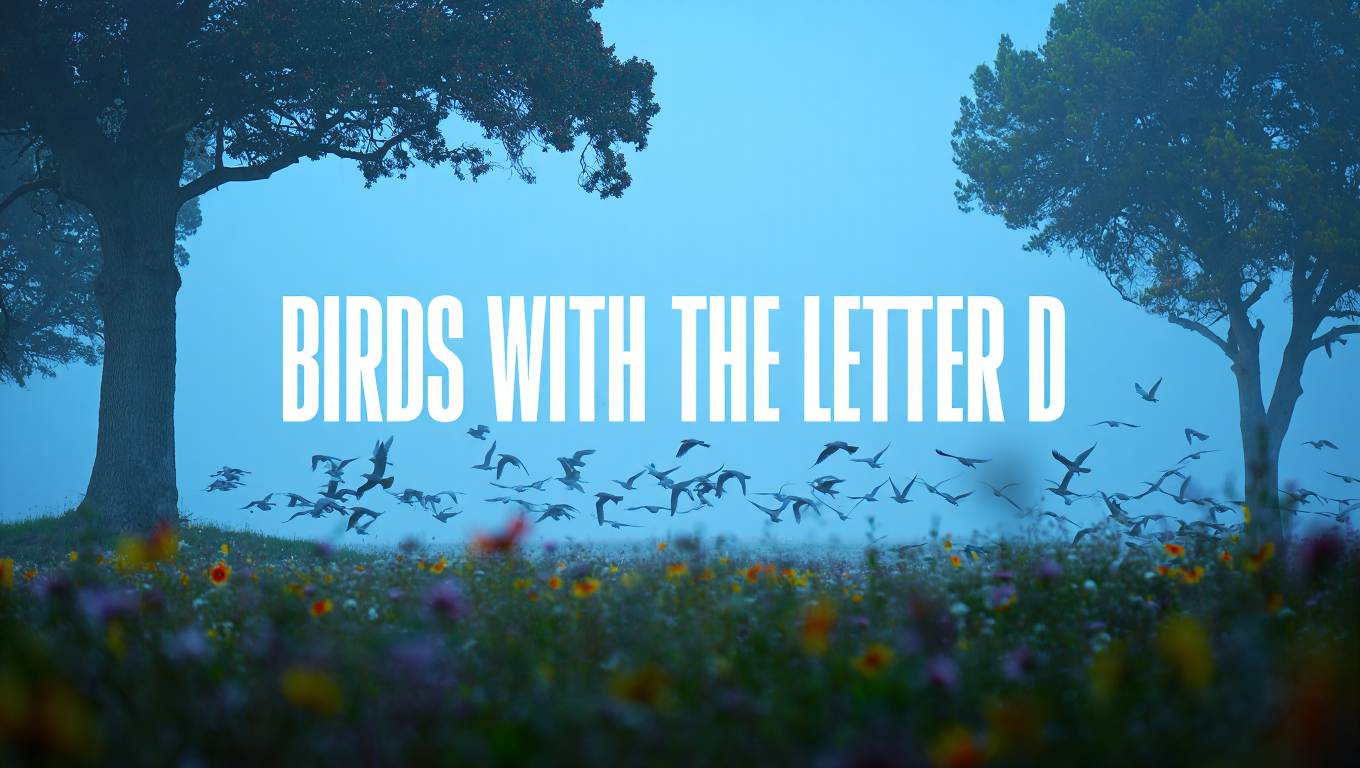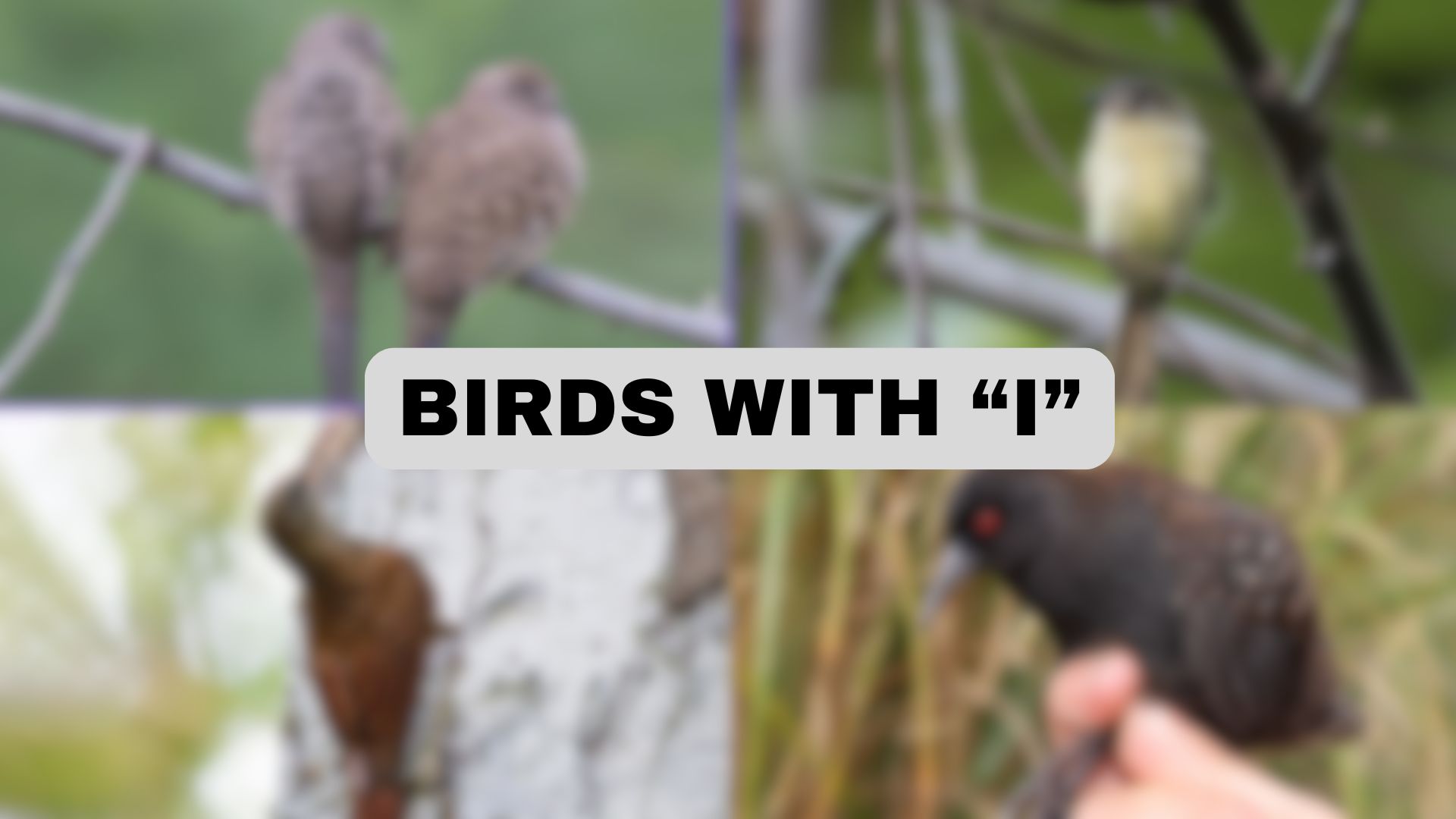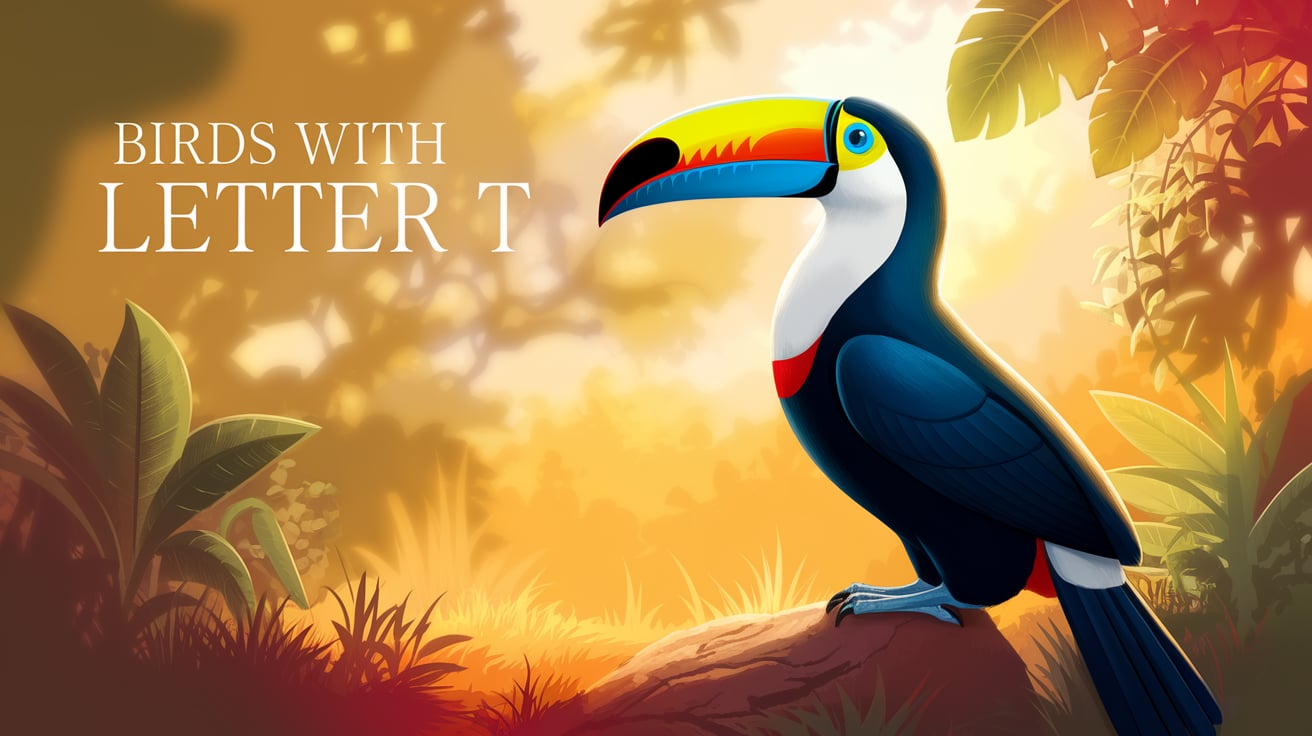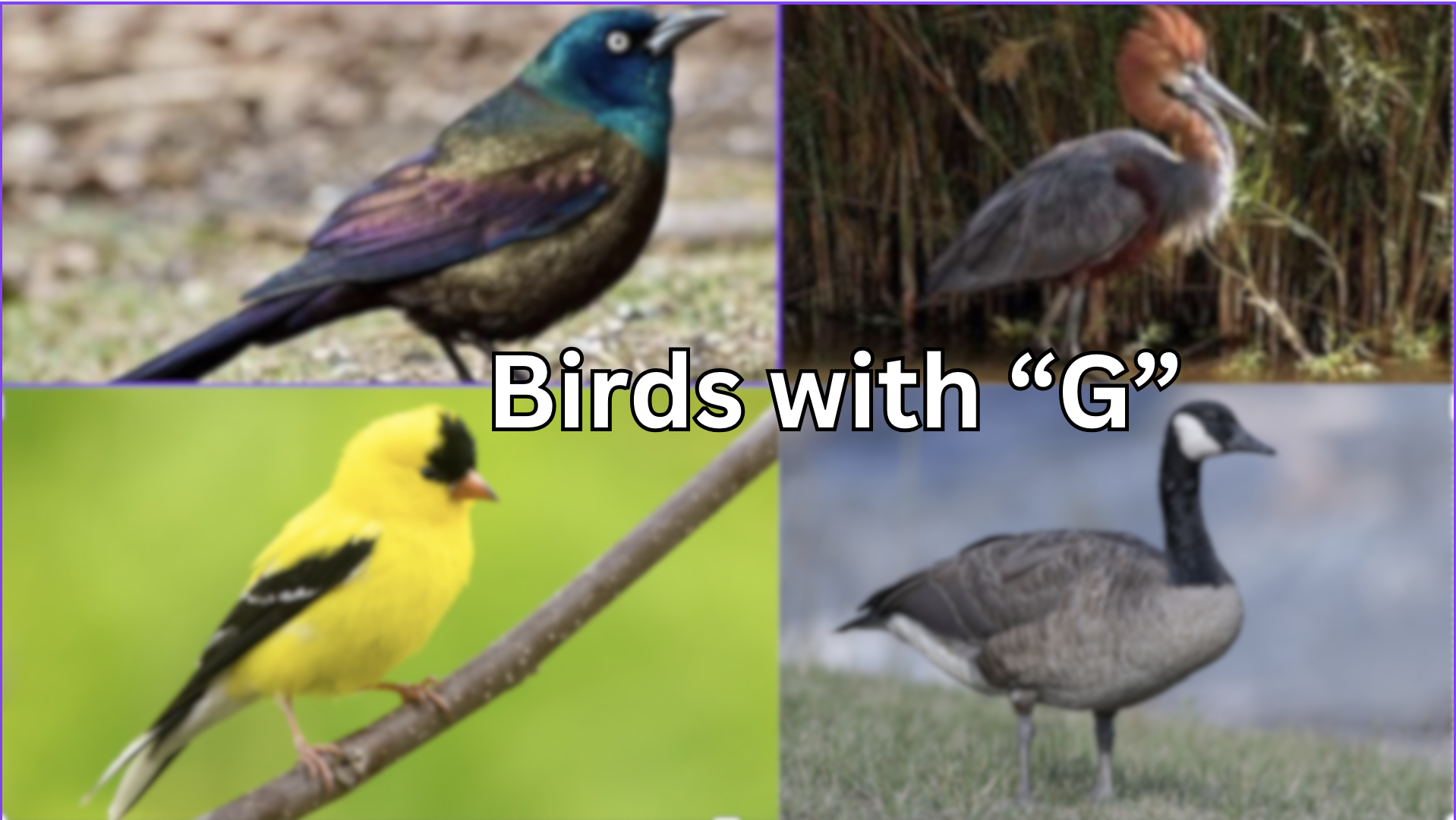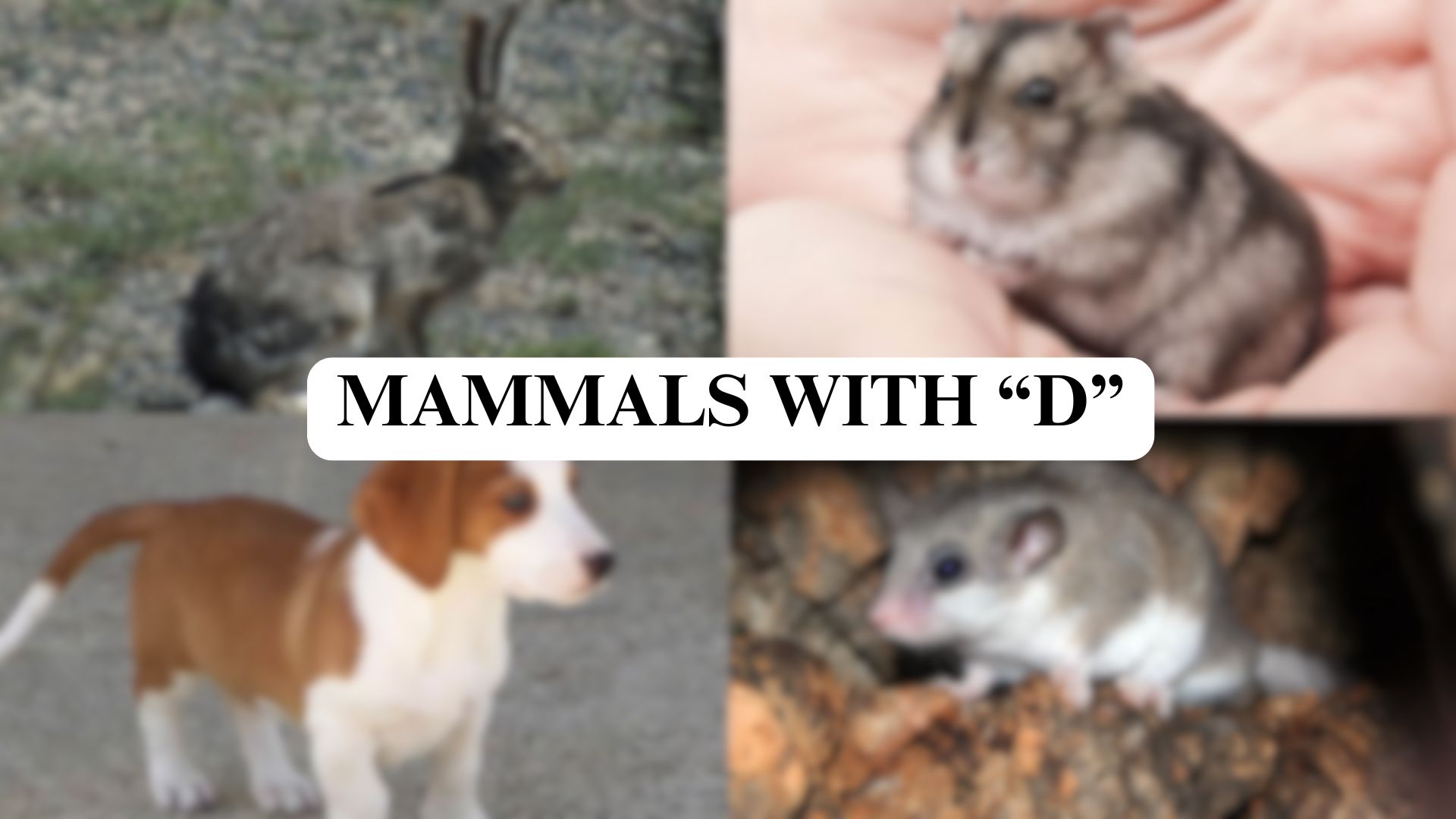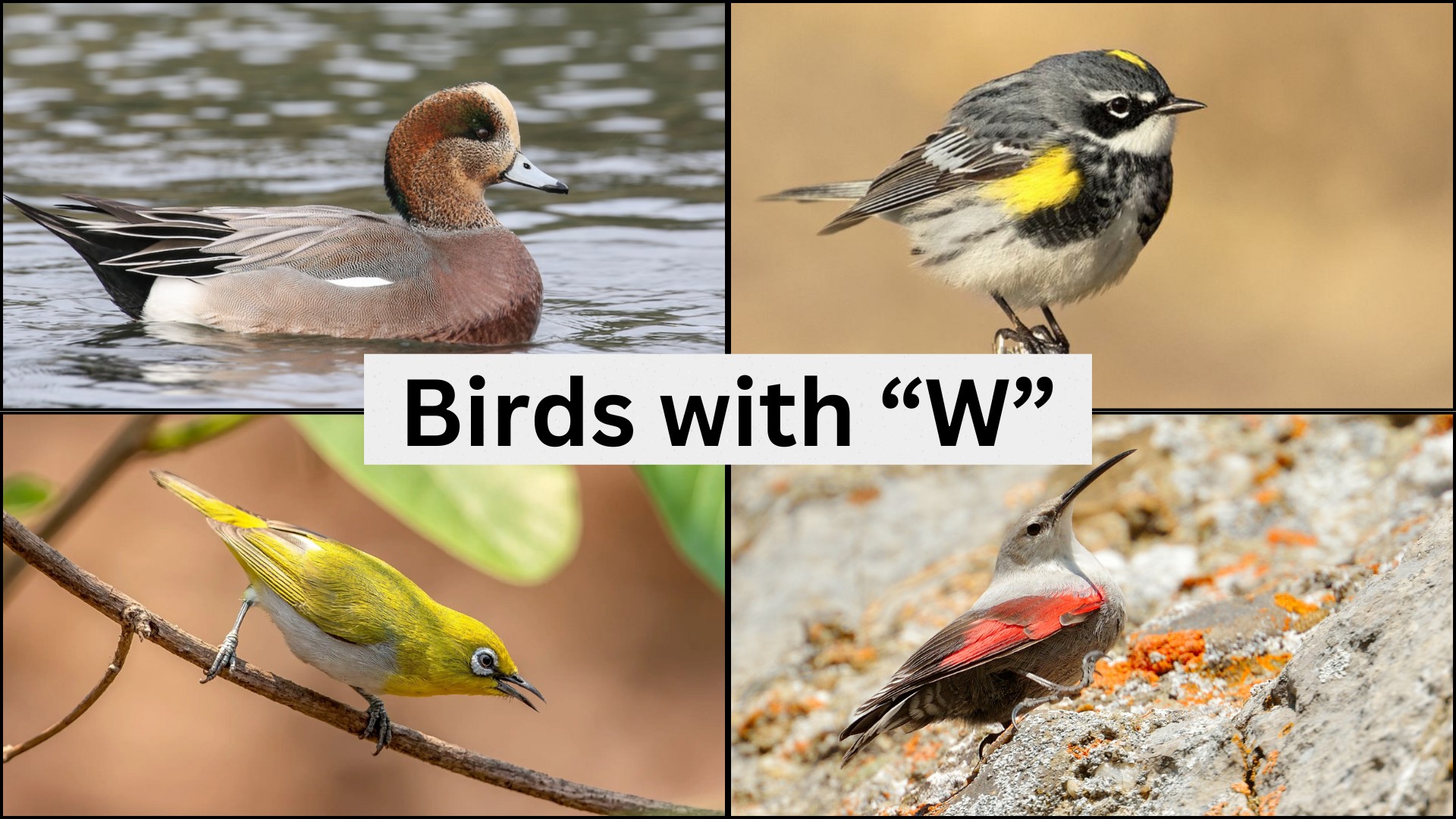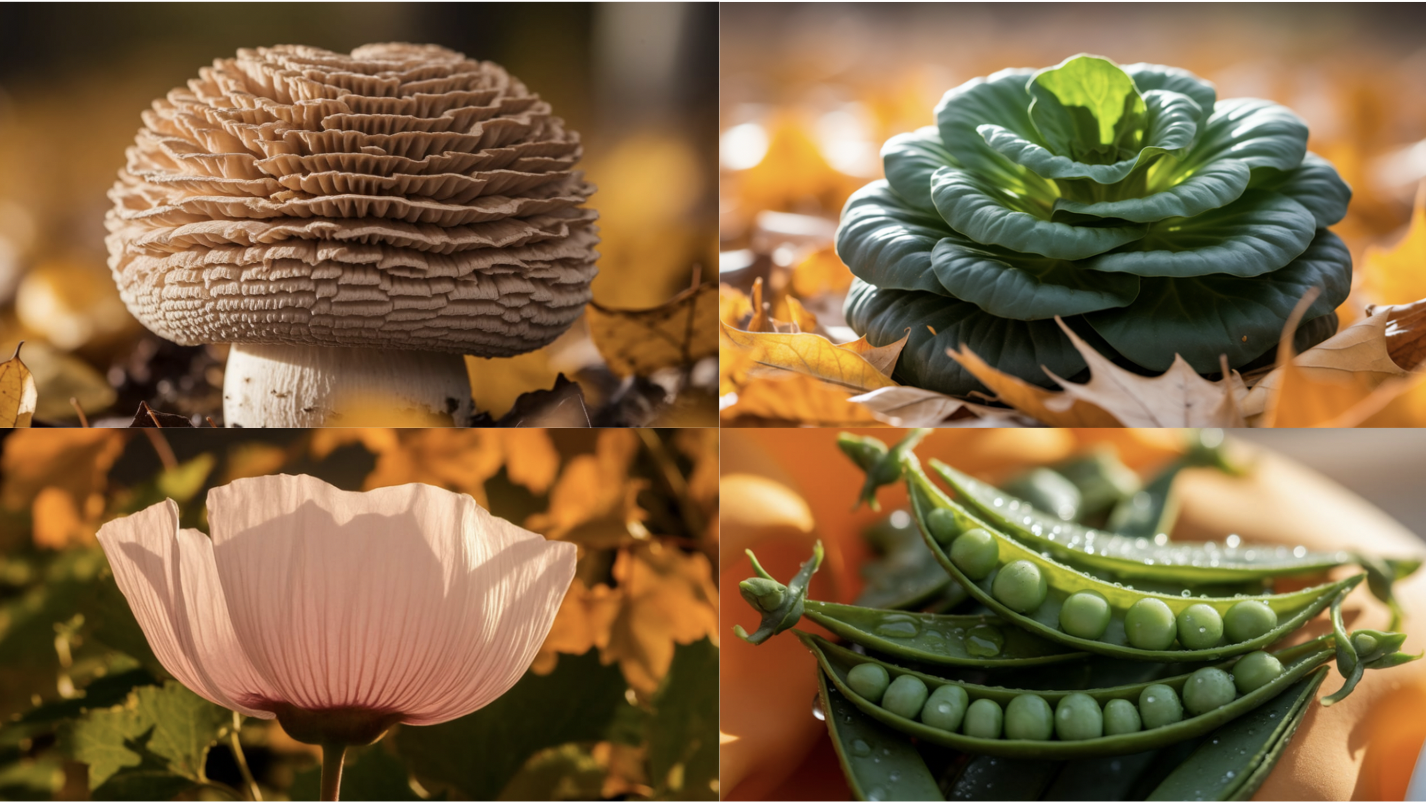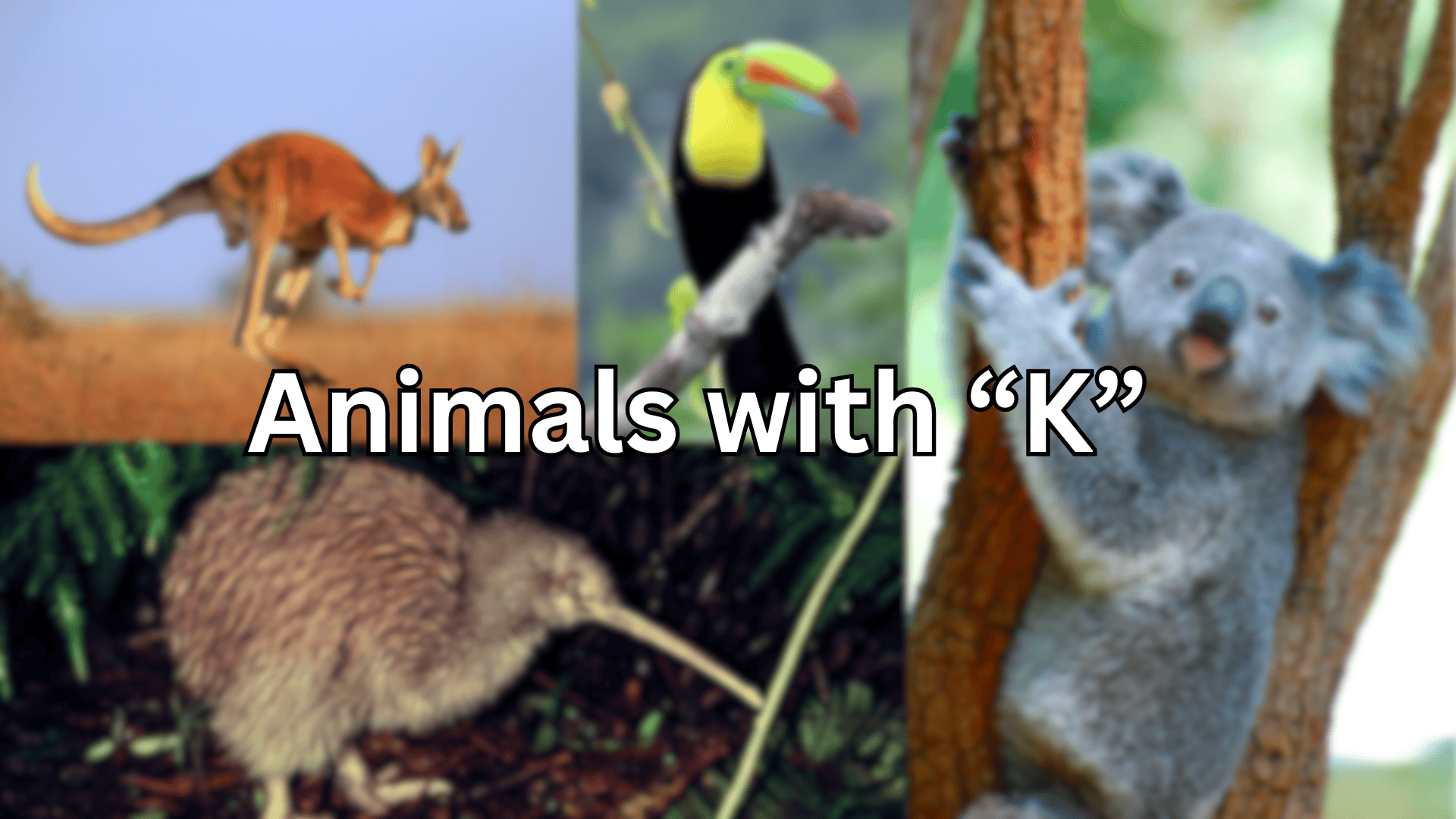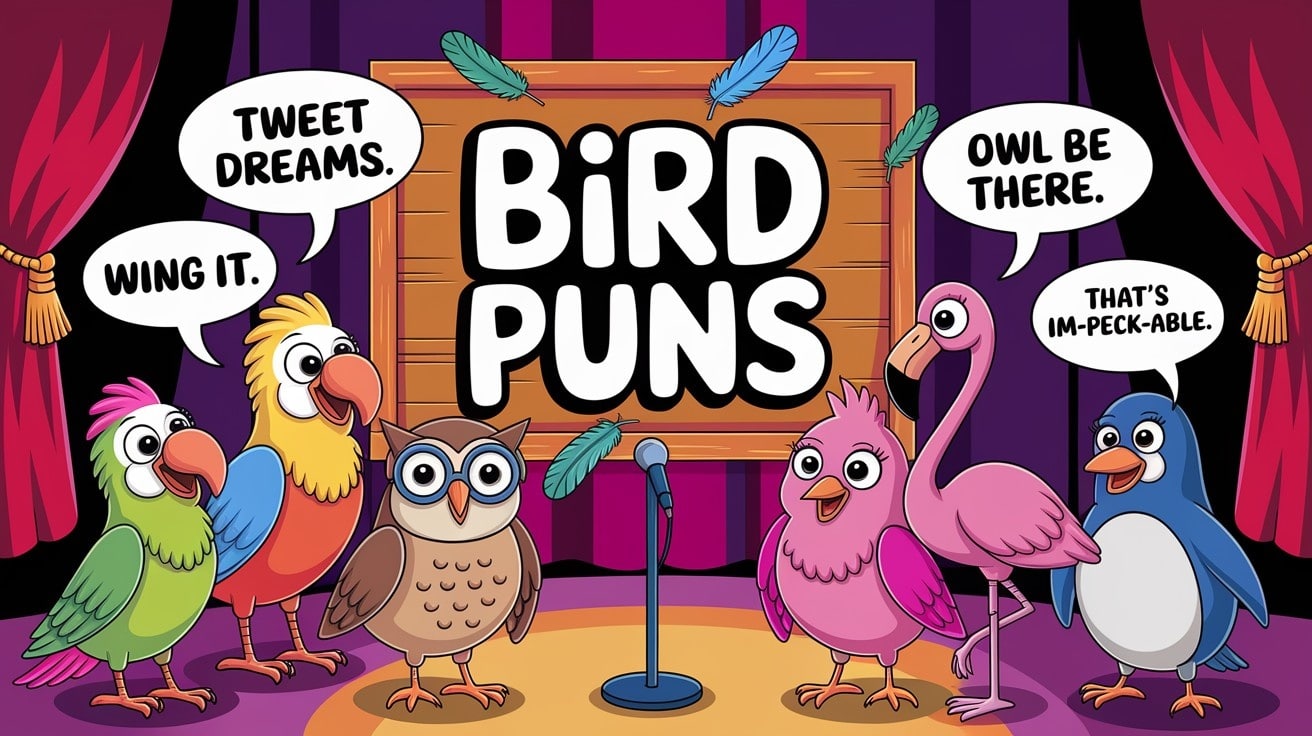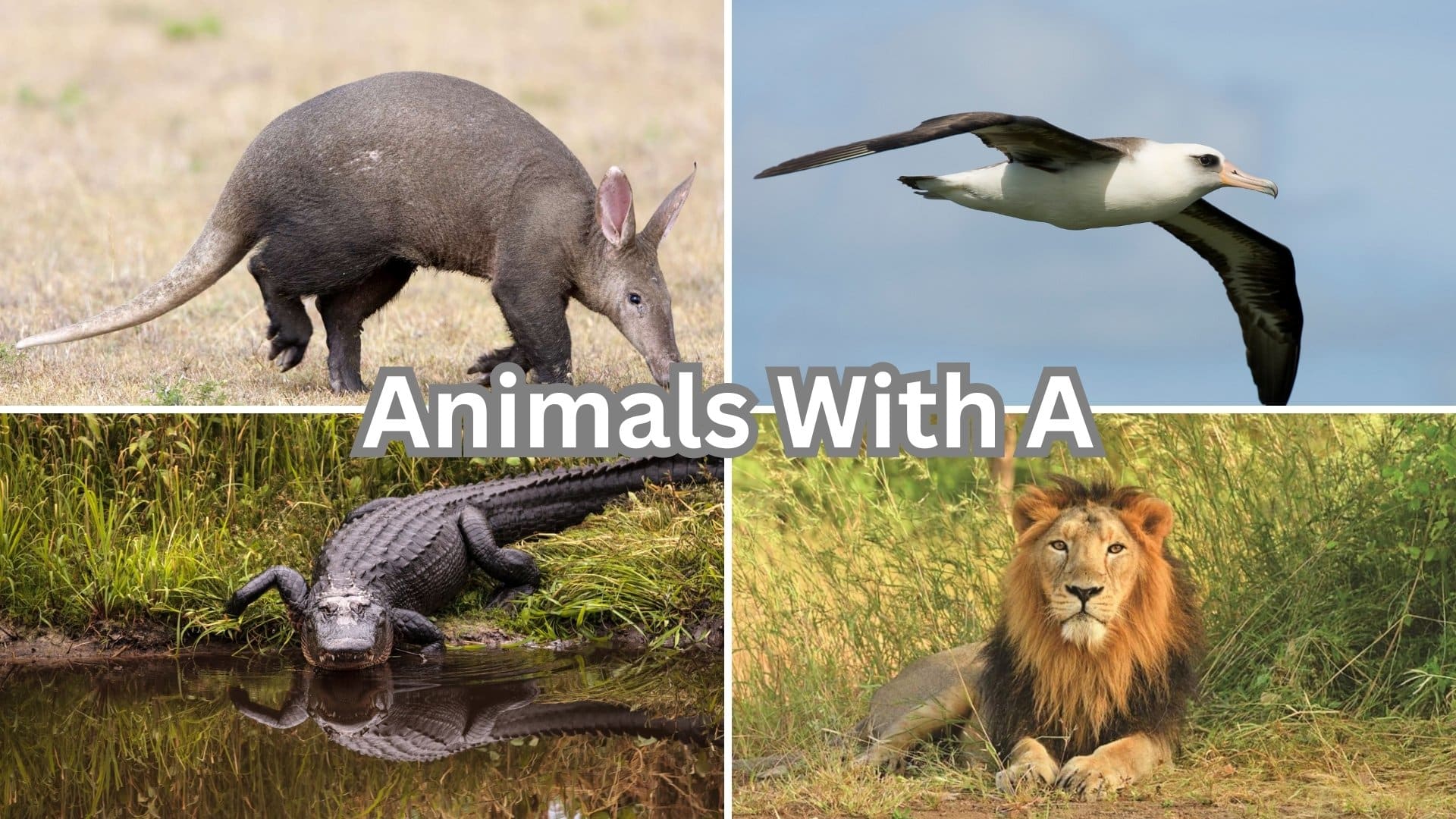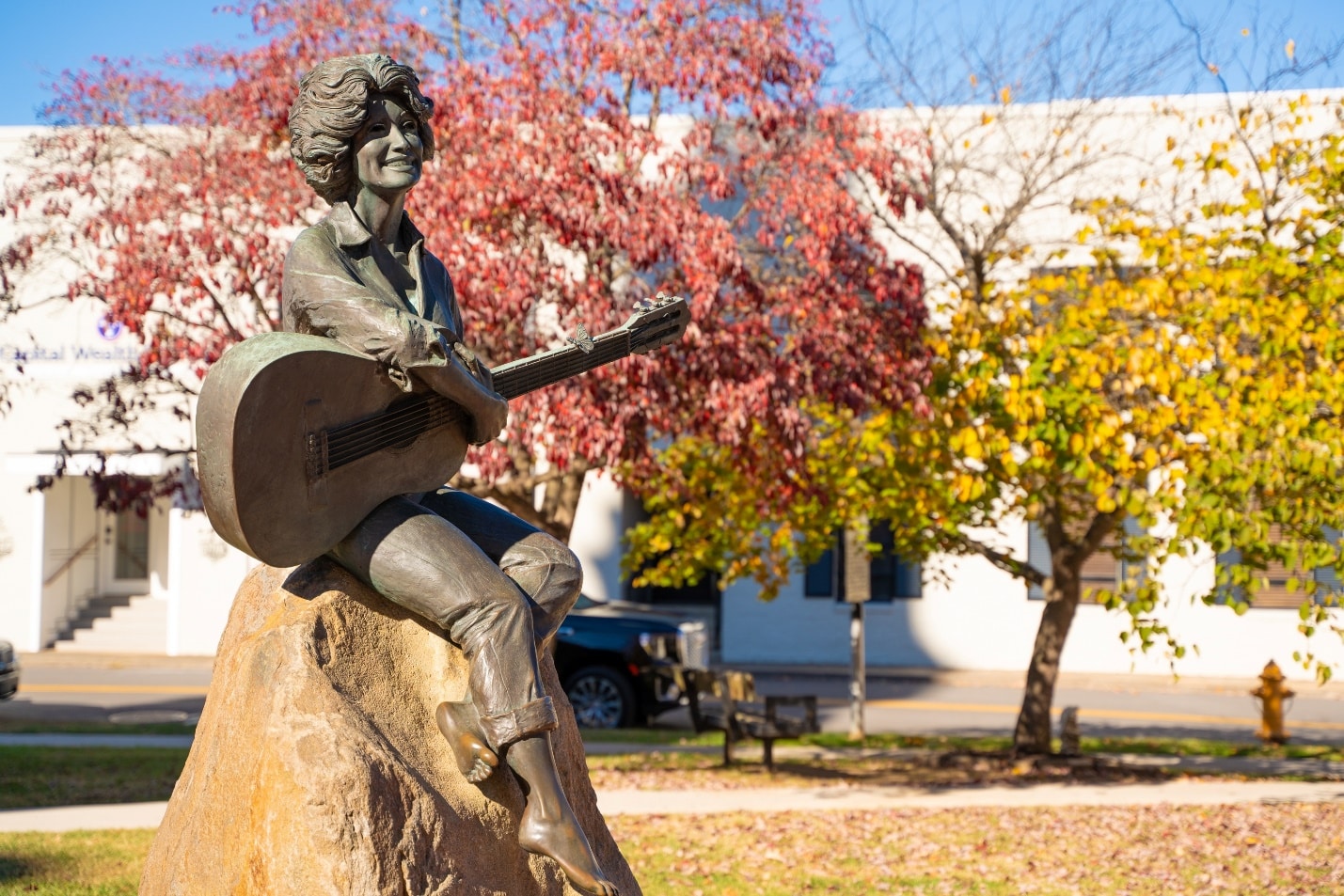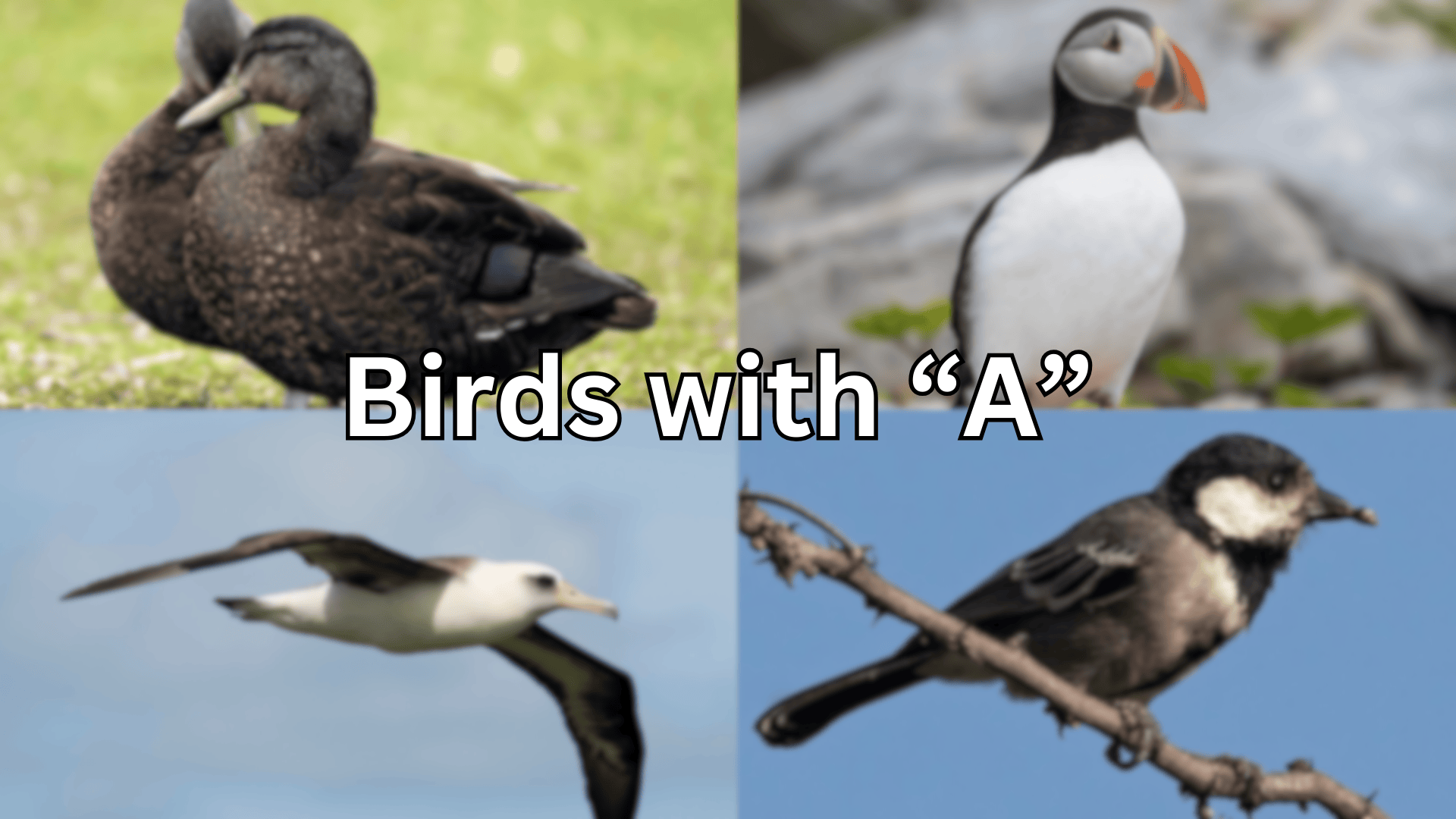
The avian world is filled with incredible diversity, and birds whose names start with “A” showcase this variety beautifully.
From the powerful Albatross to the colorful Andean Cock-of-the-rock, these beautiful creatures inhabit diverse ecosystems worldwide.
This blog provides essential information on “A” bird’s appearance, natural habitat, scientific classification, dietary preferences, and unique vocalizations.
These species offer a perfect starting point if you’re planning a birding expedition, completing a wildlife photography project, or simply expanding your ornithological knowledge.
Learn about these winged wonders, their remarkable adaptations, and the surprising facts that make each species special.
Common Birds with “A”
1. American Robin
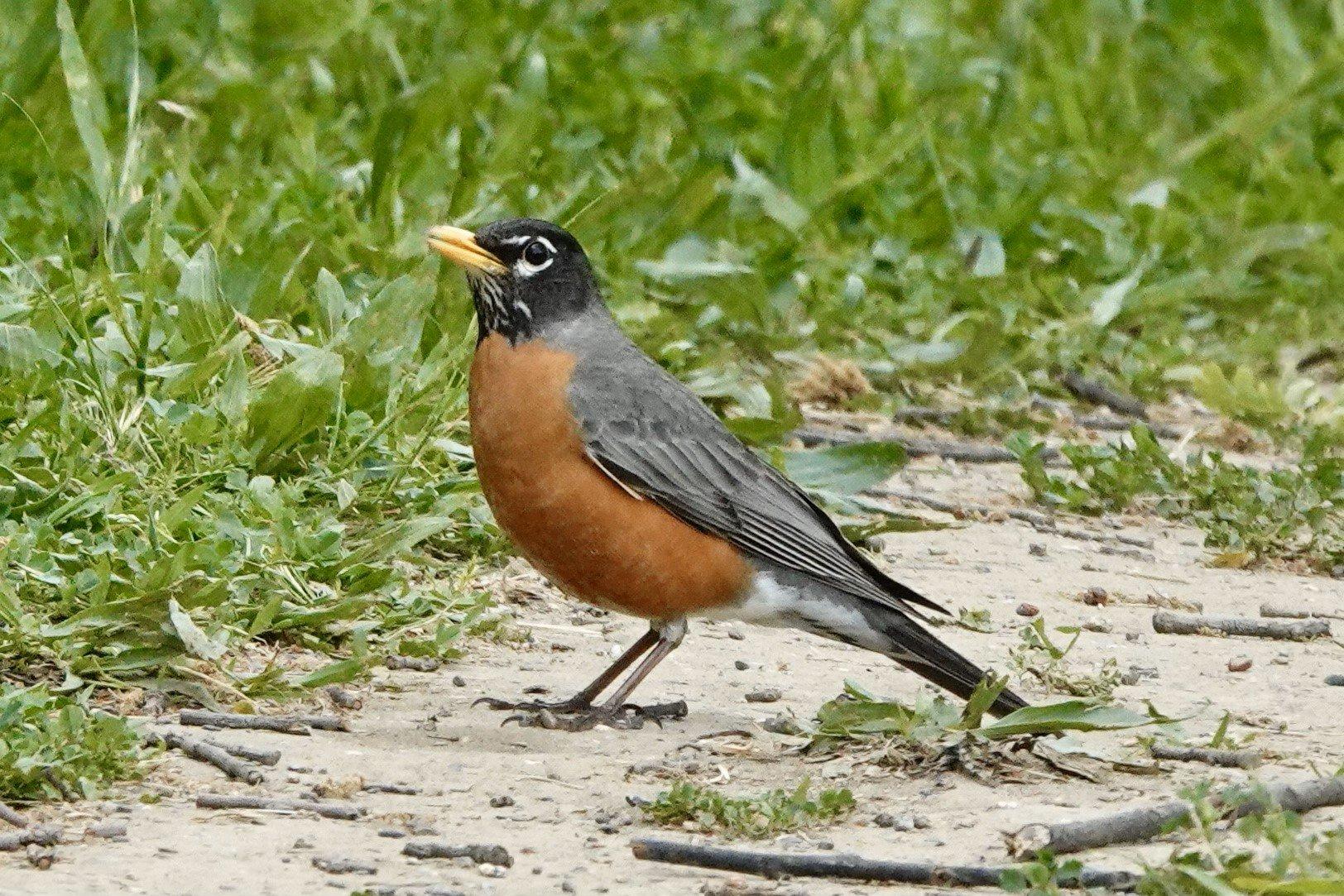
The American Robin is a medium-sized bird measuring around 7.9 to 11 inches long.
It has a distinctive orange-red breast, gray upperparts, and a white lower belly. Its slender yellow beak and upright stance make it easily recognizable in backyards and woodlands across North America.
- Region of Habitat: Found across North America, from southern Canada to Mexico, in woodlands, gardens, and urban areas.
- Scientific Name:Turdus migratorius
- Feeding Habits: Eats earthworms, insects, and berries. Often seen foraging on lawns and grassy areas.
- What Sound They Make: A rich, melodic song made up of clear whistles, often heard at dawn.
Fun Fact:
American Robins are among the earliest birds to start singing each morning, often before sunrise. They can produce up to 100 different song phrases, varying their tunes with the season and time of day.
2. American Crow
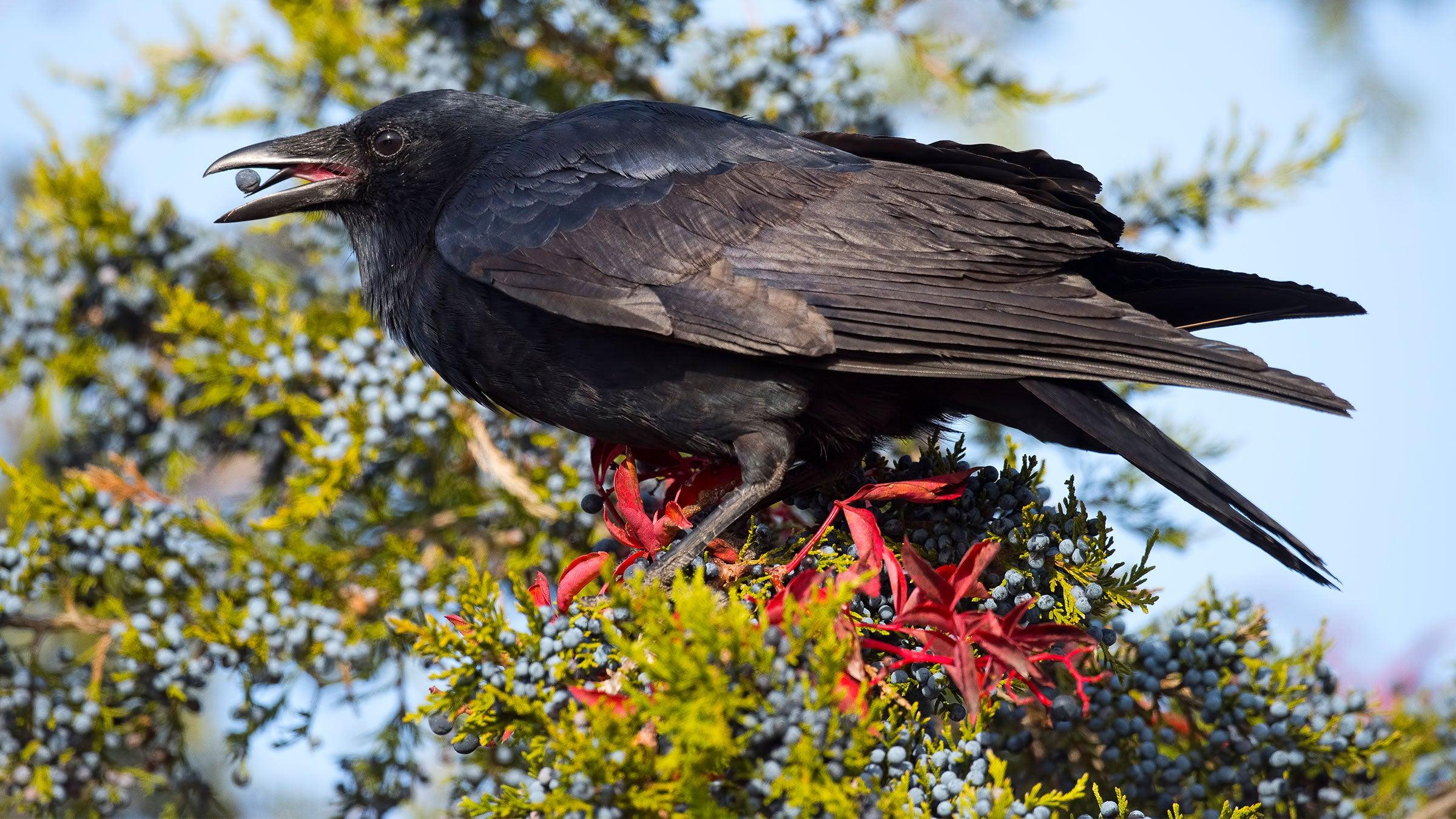
The American Crow is a large, glossy black bird measuring about 16 to 20 inches.
It has a strong, stout bill, broad wings, and a fan-shaped tail. Highly intelligent, it’s known for its adaptability and complex social behavior.
- Region of Habitat: Widely distributed across North America in fields, forests, towns, and cities.
- Scientific Name:Corvus brachyrhynchos
- Feeding Habits: Omnivorous and opportunistic—feeds on insects, seeds, fruits, carrion, and human food waste.
- What Sound They Make: Distinctive “caw-caw” calls are used for communication, warnings, and social bonding.
Fun Fact:
American Crows can recognize human faces and remember people who threaten them. They use tools, solve puzzles, and even hold “funerals” by gathering around dead crows.
3. American Goldfinch
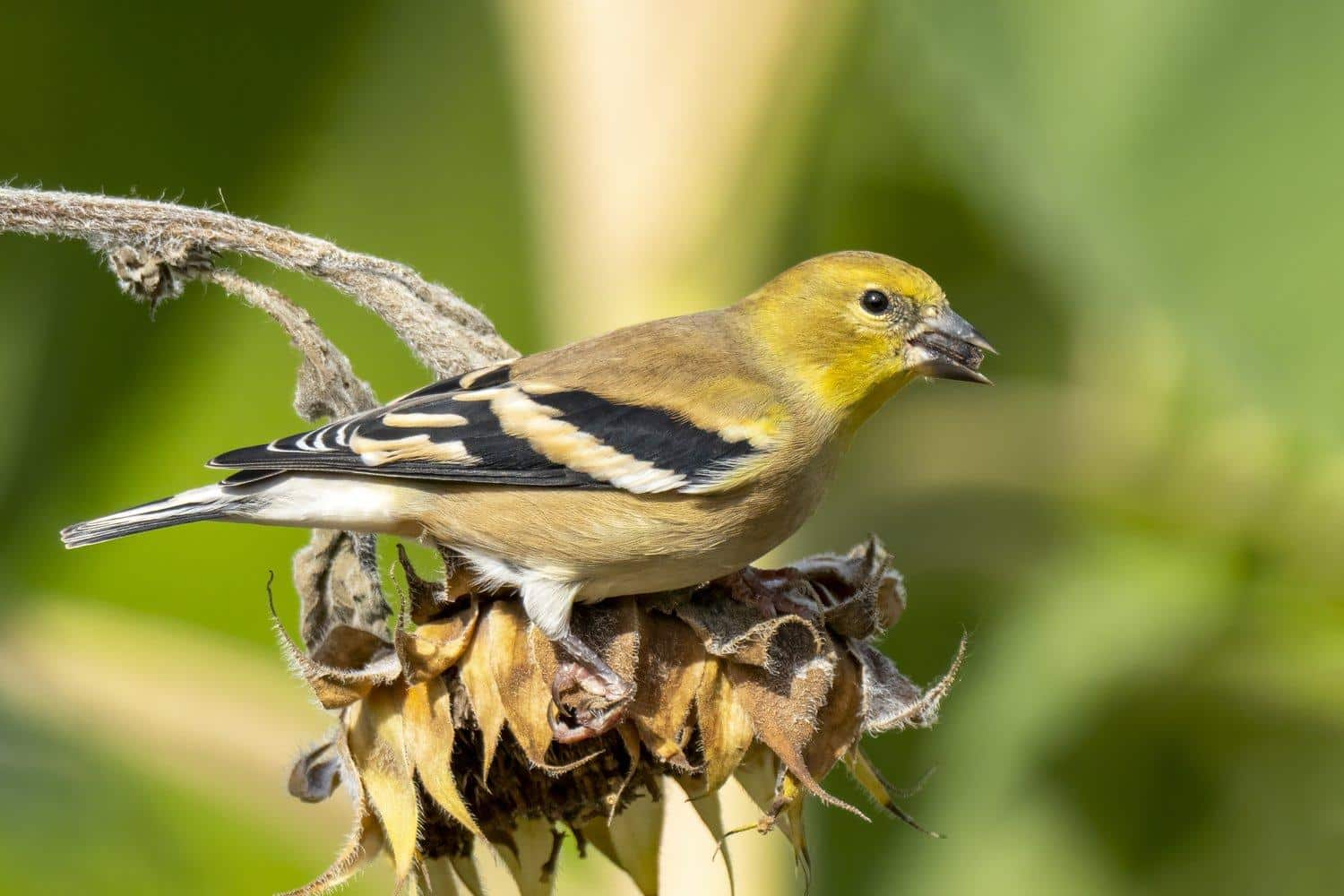
This small songbird is about 4 to 5 inches long and is instantly recognizable by its bright yellow body and black wings and cap (in males during summer).
Females are more muted in color. It has a short, conical bill perfect for eating seeds.
- Region of Habitat: Found across southern Canada and the U.S., especially in weedy fields, orchards, and backyards.
- Scientific Name:Spinus tristis
- Feeding Habits: Feeds primarily on seeds, particularly from sunflowers, thistles, and dandelions.
- What Sound They Make: Emits a cheerful, canary-like song with a lilting “per-chic-o-ree.
Fun Fact:
Unlike many songbirds, American Goldfinches breed late in summer when seeds are most abundant. They undergo a dramatic molt twice a year, changing from dull winter plumage to vibrant yellow in spring.
4. American Kestrel
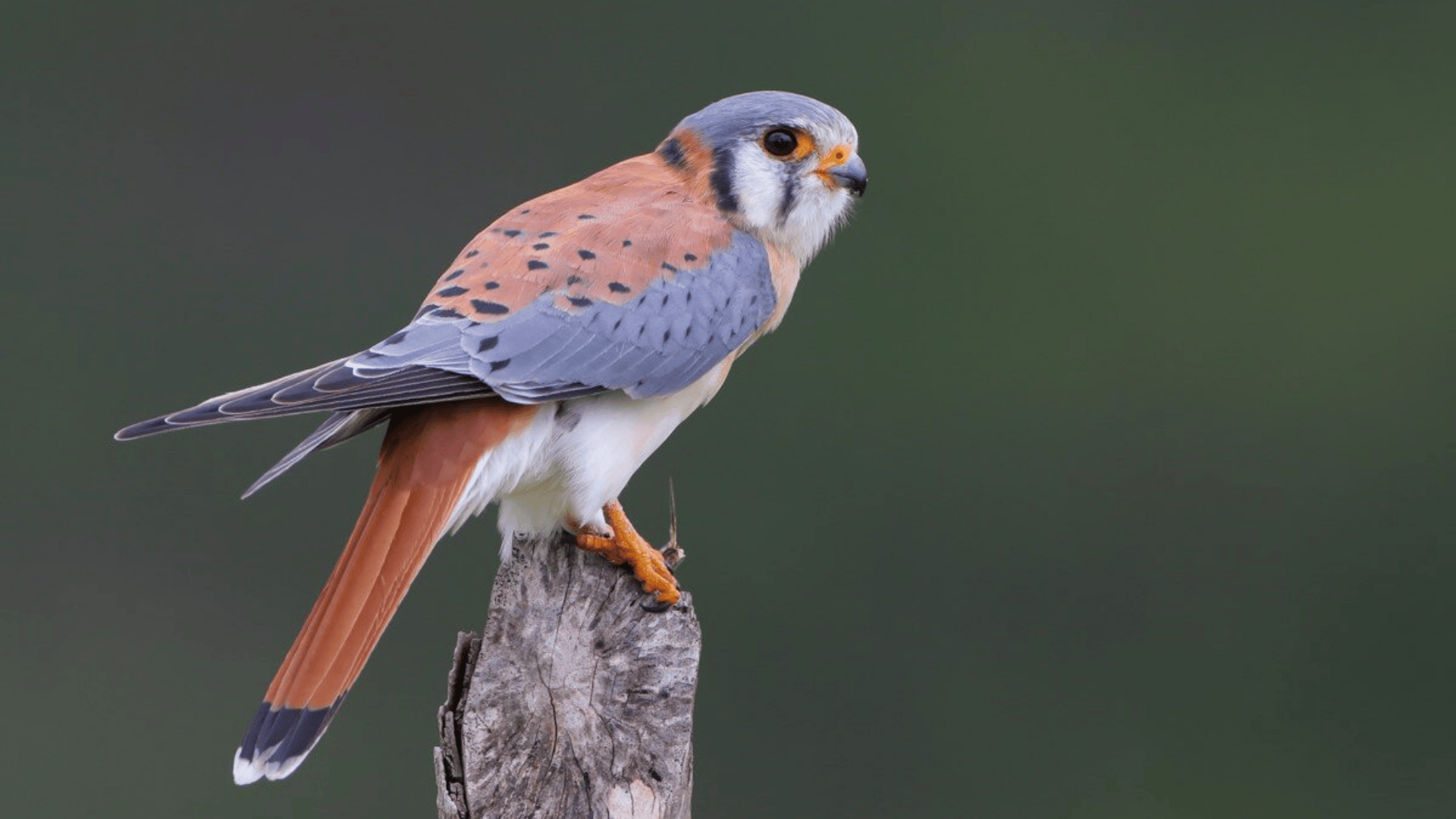
The American Kestrel is the smallest falcon in North America, measuring 9 to 12 inches long.
It has a reddish-brown back and tail, blue-gray wings (in males), and bold facial markings. It’s swift and agile and often seen hovering in open fields.
- Region of Habitat: Lives throughout North and South America, favoring open country, meadows, deserts, and urban areas.
- Scientific Name:Falco sparverius
- Feeding Habits: It hunts insects, small mammals, and birds, often swooping down from perches or hovering in mid-air.
- What Sound They Make: A rapid, high-pitched “klee-klee-klee,” especially when alarmed or during courtship.
Fun Fact:
American Kestrels use ultraviolet vision to detect rodent urine trails. They can nest in tree cavities, cliffs, or even man-made nest boxes.
5. American Flamingo
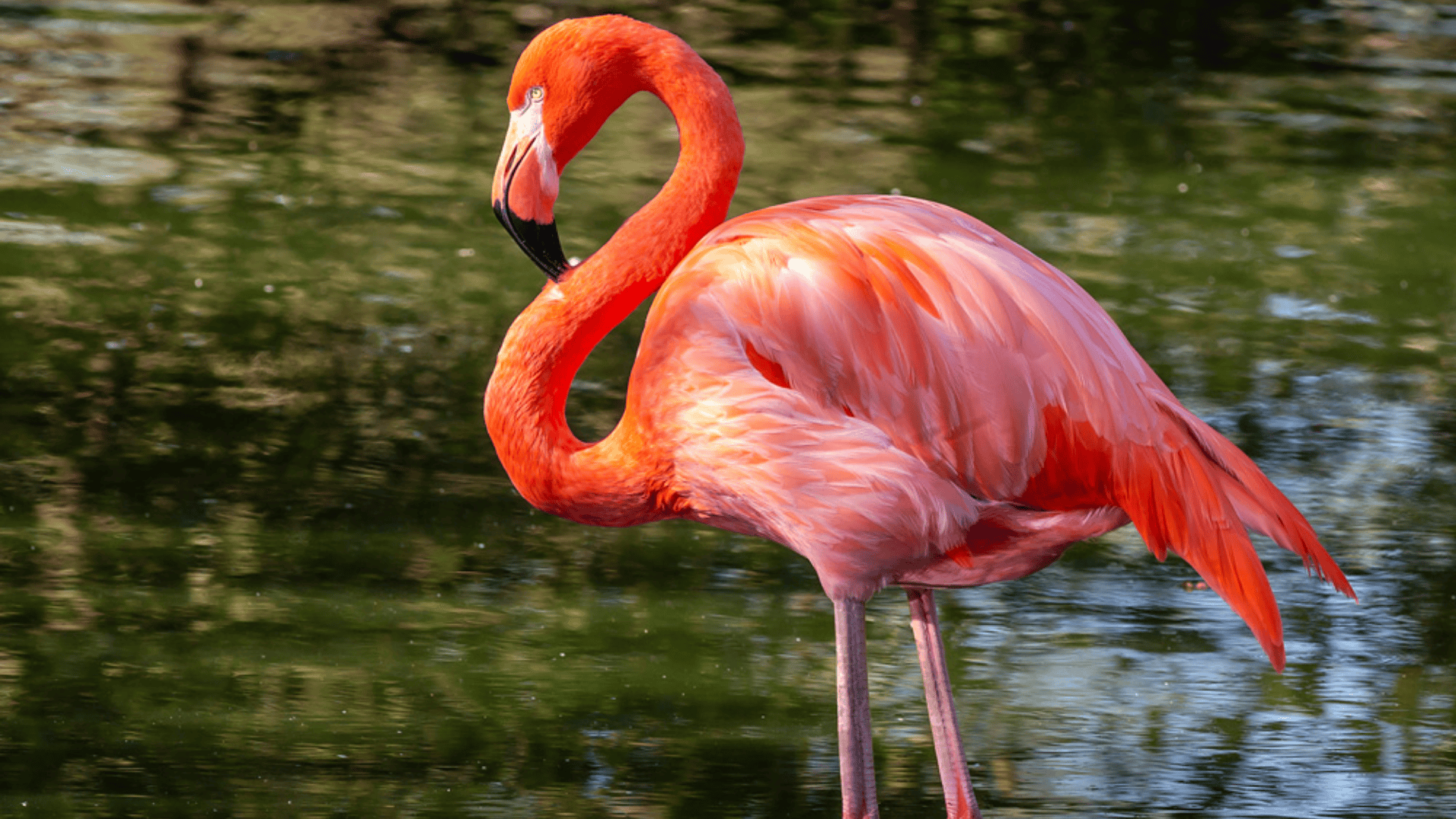
This tall, wading bird can reach 5 feet tall. It has striking pink plumage, long legs, and a unique down-curved bill adapted for filter-feeding in shallow waters.
Its graceful posture and vibrant color make it one of the most recognizable birds in wetlands and lagoons.
- Region of Habitat: Inhabits shallow lagoons, lakes, and coastal areas in the Caribbean, northern South America, and occasionally the southeastern U.S.
- Scientific Name:Phoenicopterus ruber
- Feeding Habits: Feeds on algae, plankton, and tiny crustaceans by filtering water with its specialized bill.
- What Sound They Make: They emit low honking or grunting calls in large colonies.
Fun Fact:
Flamingos’ pink color comes from carotenoid pigments in their food, especially shrimp and algae. They often stand on one leg to conserve body heat and reduce fatigue.
6. American Black Duck
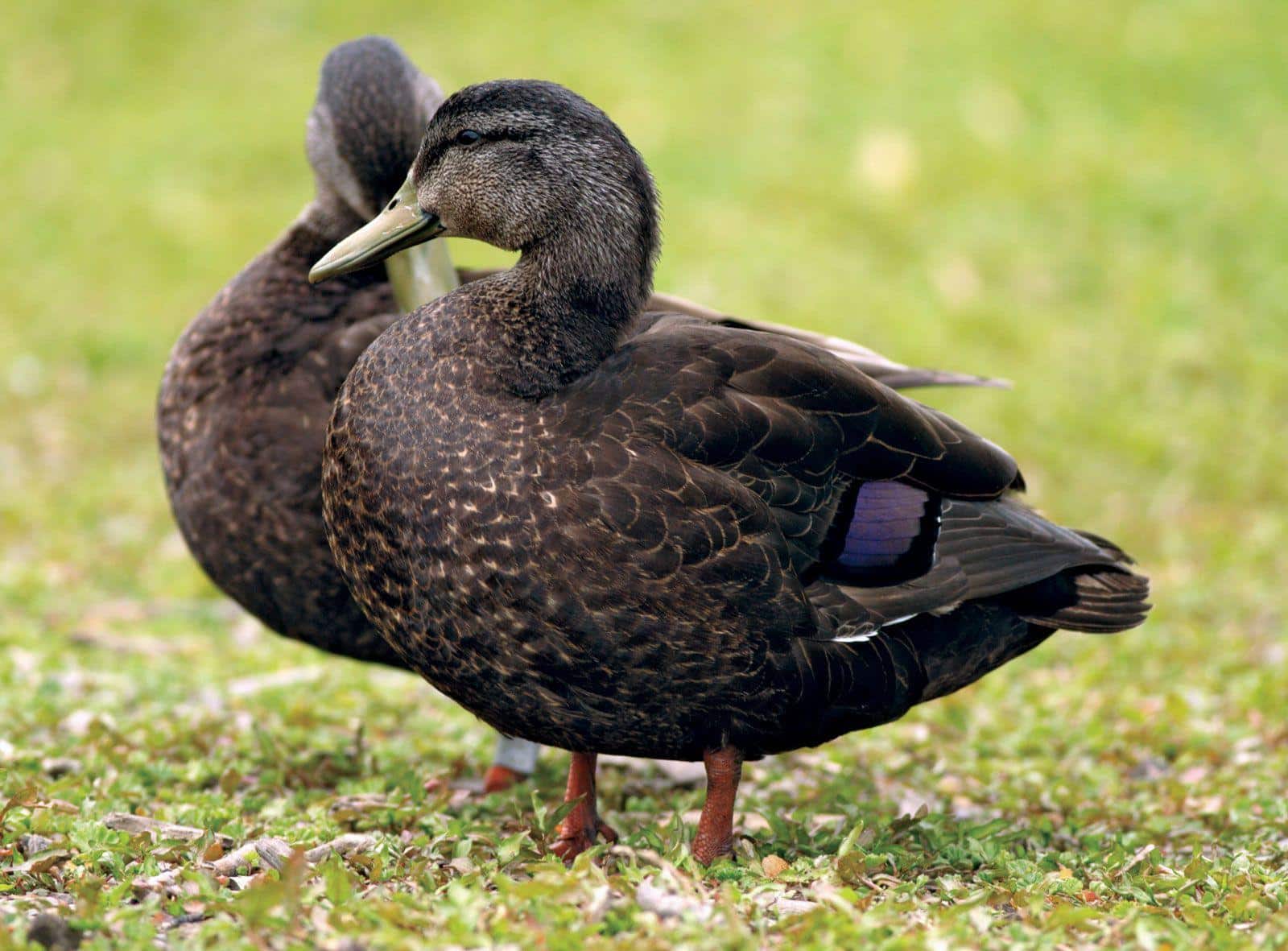
This large dabbling duck measures about 20 to 26 inches in length. It has a dark brown body, lighter head, and a purplish-blue speculum (wing patch).
Males and females look similar. Its sturdy build and subtle coloring help it blend seamlessly into marshy environments.
- Region of Habitat: Found in eastern North America in freshwater and coastal marshes, lakes, and ponds.
- Scientific Name:Anas rubripes
- Feeding Habits: Feeds on aquatic plants, insects, seeds, and crustaceans by dabbling in shallow water.
- What Sound They Make: Females give a loud quacking similar to mallards; males have quieter whistles.
Fun Fact:
American Black Ducks are more shy and elusive than mallards, often preferring secluded wetlands. They frequently hybridize with mallards, which has contributed to their population decline.
7. American Bittern
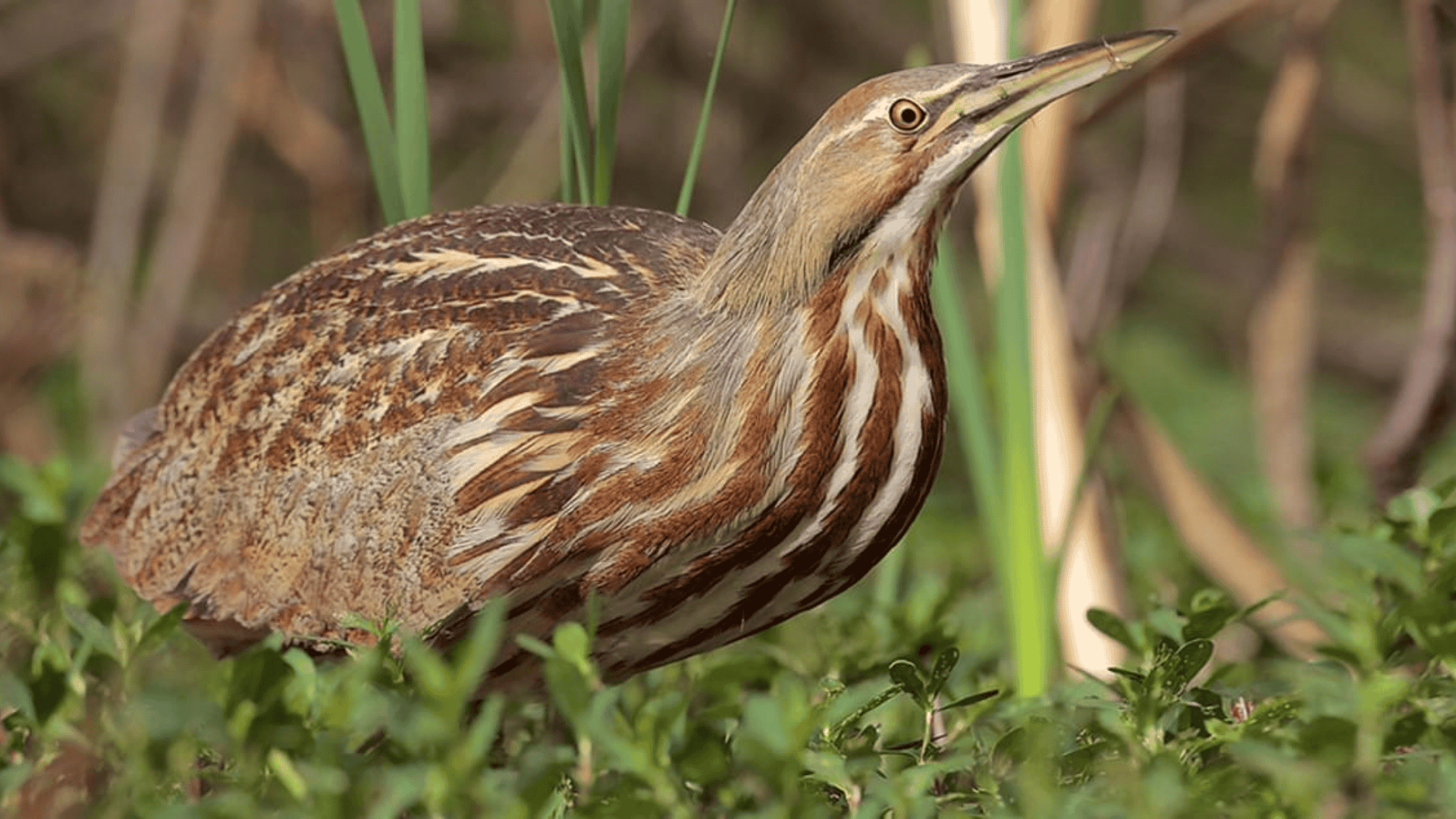
A medium-sized heron, about 23 to 34 inches long, with a streaky brown body perfect for camouflage in reeds.
It has a long neck and dagger-like bill used to spear prey.
- Region of Habitat: Found in marshes and wetlands across North America, especially during breeding season.
- Scientific Name:Botaurus lentiginosus
- Feeding Habits: Ambush predator that feeds on fish, insects, amphibians, and crustaceans.
- What Sound They Make: Known for its bizarre, booming “pump-er-lunk” call that echoes through marshes.
Fun Fact:
When threatened, it freezes and points its bill upward, blending into the reeds. Its call can be heard over long distances, even if the bird remains unseen.
8. American Avocet
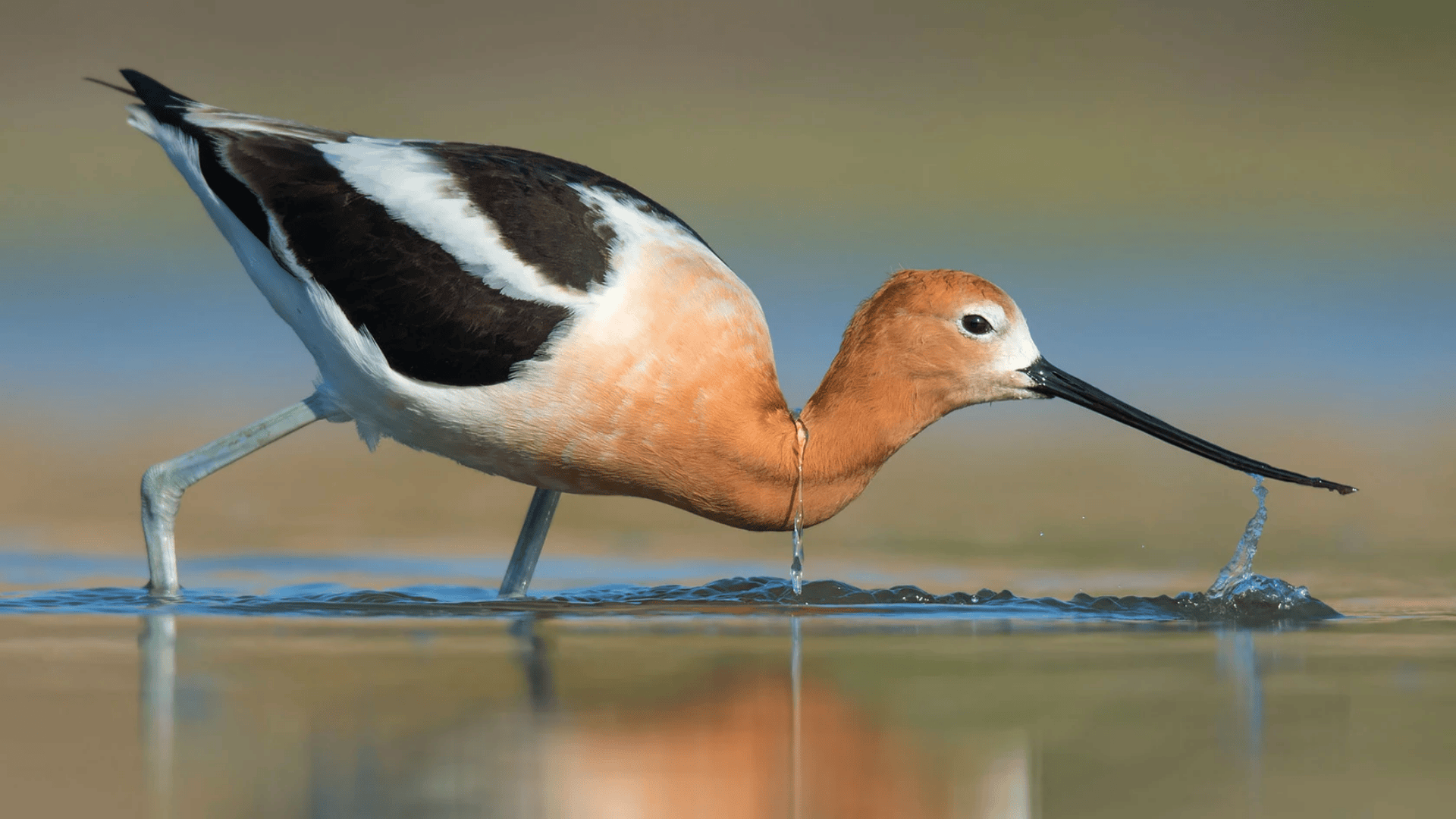
This elegant shorebird has a slender upturned bill, long bluish legs, and striking black and white plumage with a cinnamon-colored head during breeding season.
Its graceful movements and sweeping feeding style make it a standout in shallow wetlands.
- Region of Habitat: Found in wetlands, shallow lakes, and salt flats across western and central North America.
- Scientific Name:Recurvirostra americana
- Feeding Habits: It sweeps its bill side-to-side through shallow water to catch crustaceans and insects.
- What Sound They Make: Sharp, yelping “weet” calls, especially during flight or disturbance.
Fun Fact:
American Avocets perform graceful courtship dances, including synchronized movements and bill touching. Chicks can walk and swim within hours of hatching.
9. American Redstart
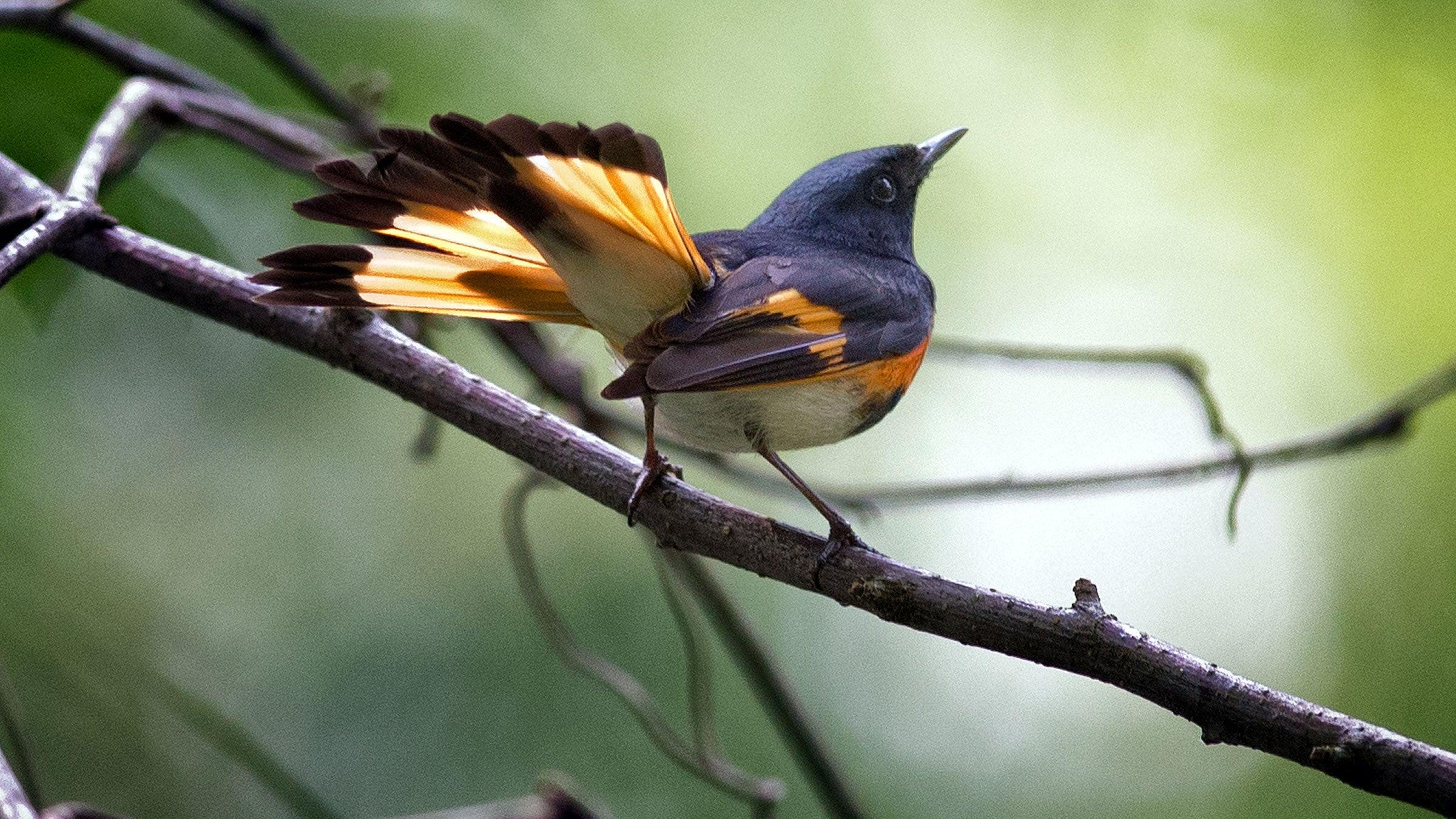
A small warbler, around 5 inches long, with males showing striking black and orange plumage and females wearing yellow and gray tones. Its tail flicking and flashing is a key ID trait.
- Region of Habitat: Found in deciduous forests, woodlands, and shrubby areas throughout North and Central America.
- Scientific Name:Setophaga ruticilla
- Feeding Habits: Eats insects and spiders, often catching them in mid-air with agile flight.
- What Sound They Make: A series of high, thin notes and trills, often rising in pitch.
Fun Fact:
American Redstarts use tail flashing to flush out insects from foliage. They migrate long distances, some traveling over 5,000 miles to winter in South America.
10. American Wigeon
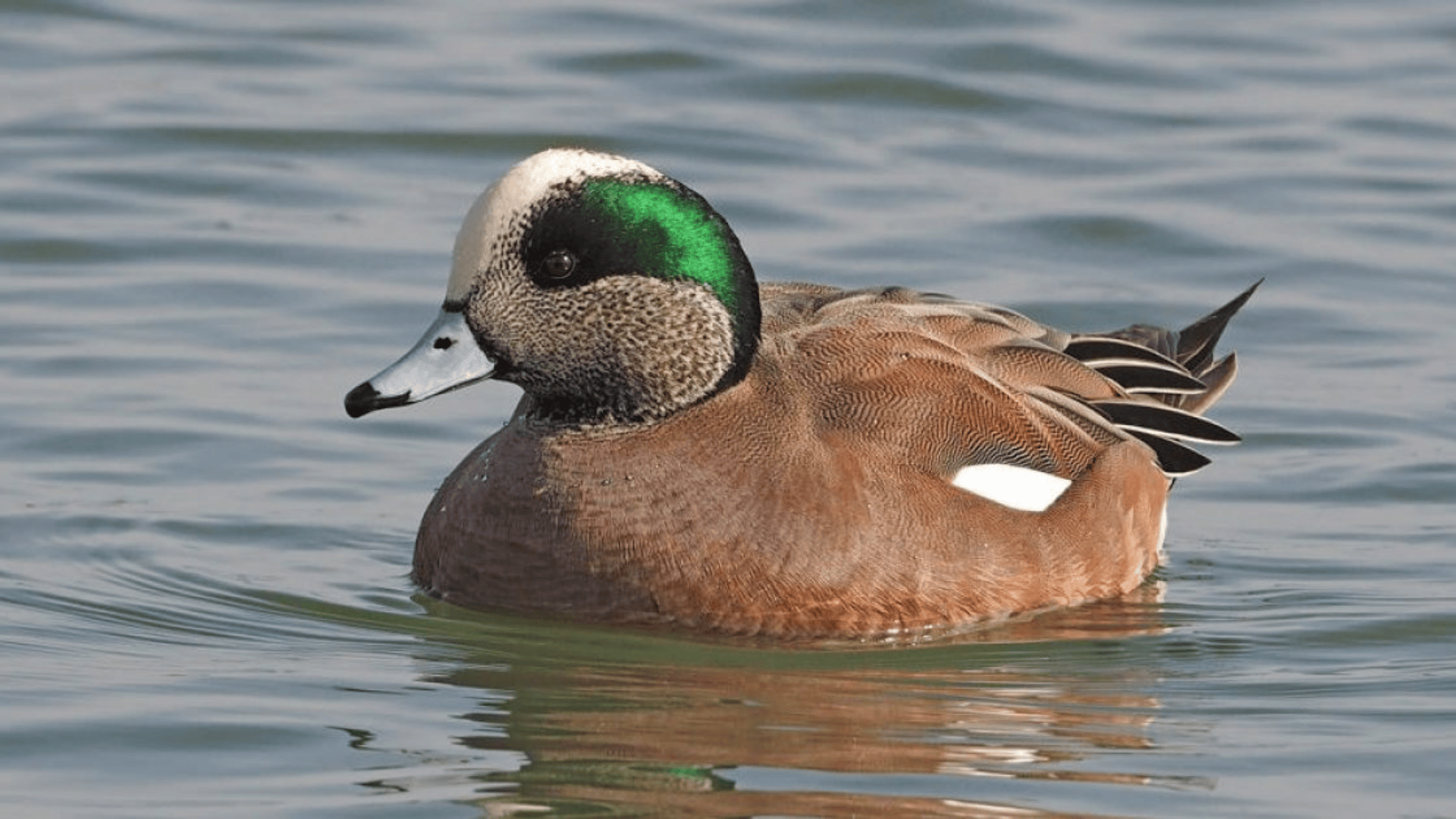
This medium-sized dabbling duck measures around 17 to 23 inches.
Males are recognized by their pale gray bodies, green eye patches, and distinctive white crown. Females are mottled brown with gray heads. It has a short, blue-gray bill with a black tip.
- Region of Habitat: Common across North America in marshes, ponds, and lakes; winters in southern U.S., Mexico, and Central America.
- Scientific Name:Mareca americana
- Feeding Habits: Grazes on aquatic vegetation, grasses, and crops; known for “stealing” food from diving ducks.
- What Sound They Make: Males emit a distinctive whistling “whee-whew”; females have a lower, hoarse quack.
Fun Fact:
American Wigeons are nicknamed “baldpate” due to the male’s white crown. They are among the most vegetarian of ducks, often grazing on land like geese.
11. American Woodcock
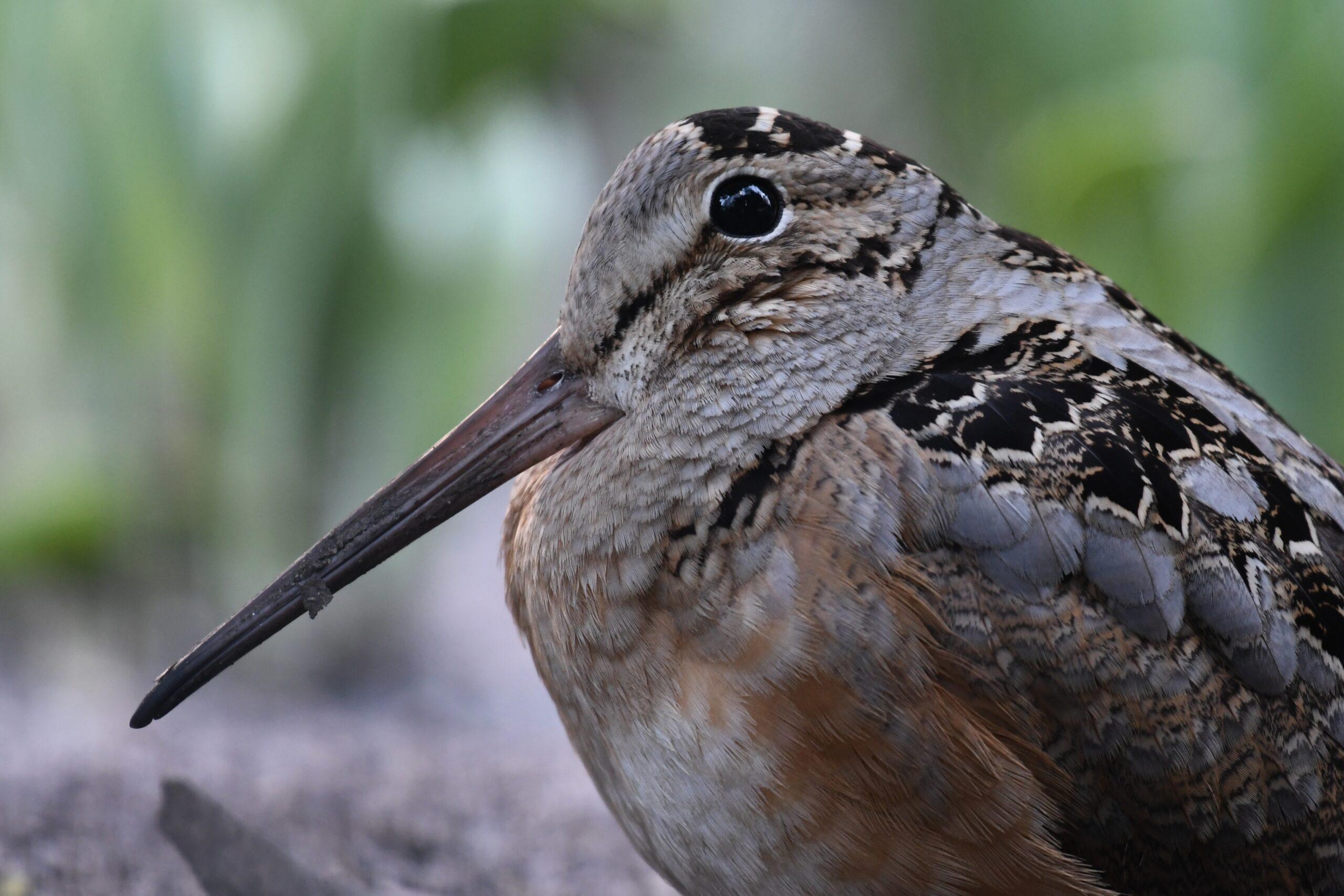
A plump, short-legged bird with mottled brown plumage, a long bill, and large eyes set high on its head.
It measures about 10 to 12 inches and blends well into the forest floor.
- Region of Habitat: Found in young forests and moist thickets in eastern North America.
- Scientific Name:Scolopax minor
- Feeding Habits: Probes soft ground for earthworms and insects using its flexible, sensitive bill.
- What Sound They Make: Males perform aerial displays with “peent” calls and twittering wing sounds.
Fun Fact:
Its eyes are positioned to give nearly 360-degree vision—perfect for spotting predators while feeding. Woodcocks perform dramatic courtship flights at dusk, spiraling into the sky and chirping on descent.
12. American Coot
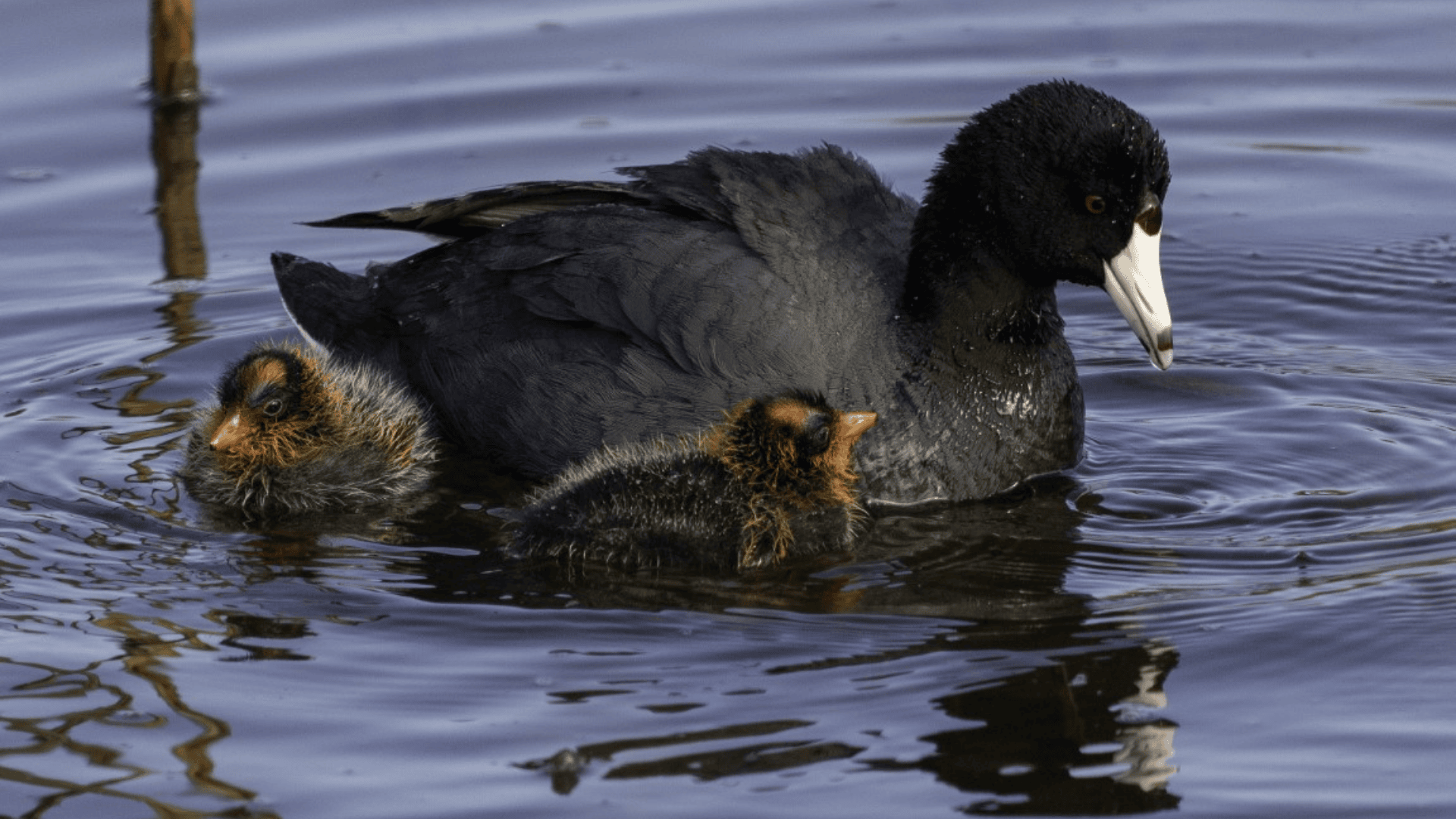
Often mistaken for a duck, this dark gray bird has a white bill and forehead shield. It measures 13 to 17 inches and has lobed, not webbed, feet for walking on land and swimming.
- Region of Habitat: Widespread across North America in freshwater ponds, lakes, and marshes.
- Scientific Name:Fulica americana
- Feeding Habits: Eats aquatic plants, insects, and small animals; dives and dabbles like ducks.
- What Sound They Make: They produce a variety of short, grunting, or clucking calls.
Fun Fact:
American Coots can be aggressive, chasing and fighting rivals during breeding season. They build floating nests anchored to aquatic plants.
13. American Tree Sparrow
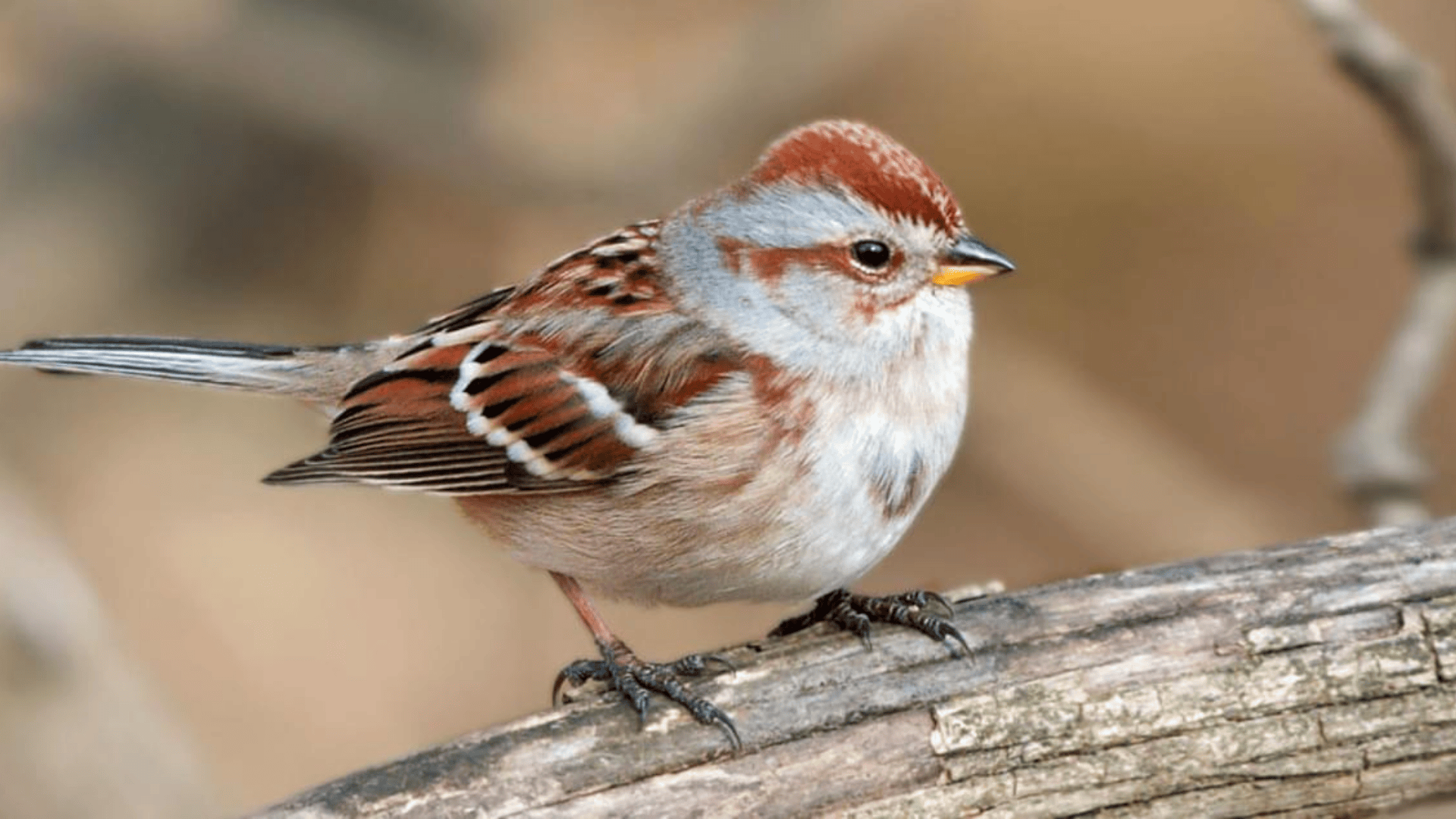
This small sparrow, around 5.5 to 7.1 inches long, has a rusty cap, bicolored bill, gray face, and a central dark spot on the chest.
It’s fluffy and often seen puffed up in cold weather. Its subtle colors help it stay camouflaged among winter grasses and shrubs.
- Region of Habitat: Breeds in the Arctic tundra; winters in the central and northern United States in weedy fields and shrubs.
- Scientific Name:Spizelloides arborea
- Feeding Habits: Forages on seeds, grasses, and insects near ground level.
- What Sound They Make: Sweet, tinkling song mixed with chirps and buzzes.
Fun Fact:
Despite its name, it’s not a tree-dwelling bird—it’s more often found in shrubs and fields. It forms large winter flocks and frequently mixes with other sparrows.
14. American Oystercatcher
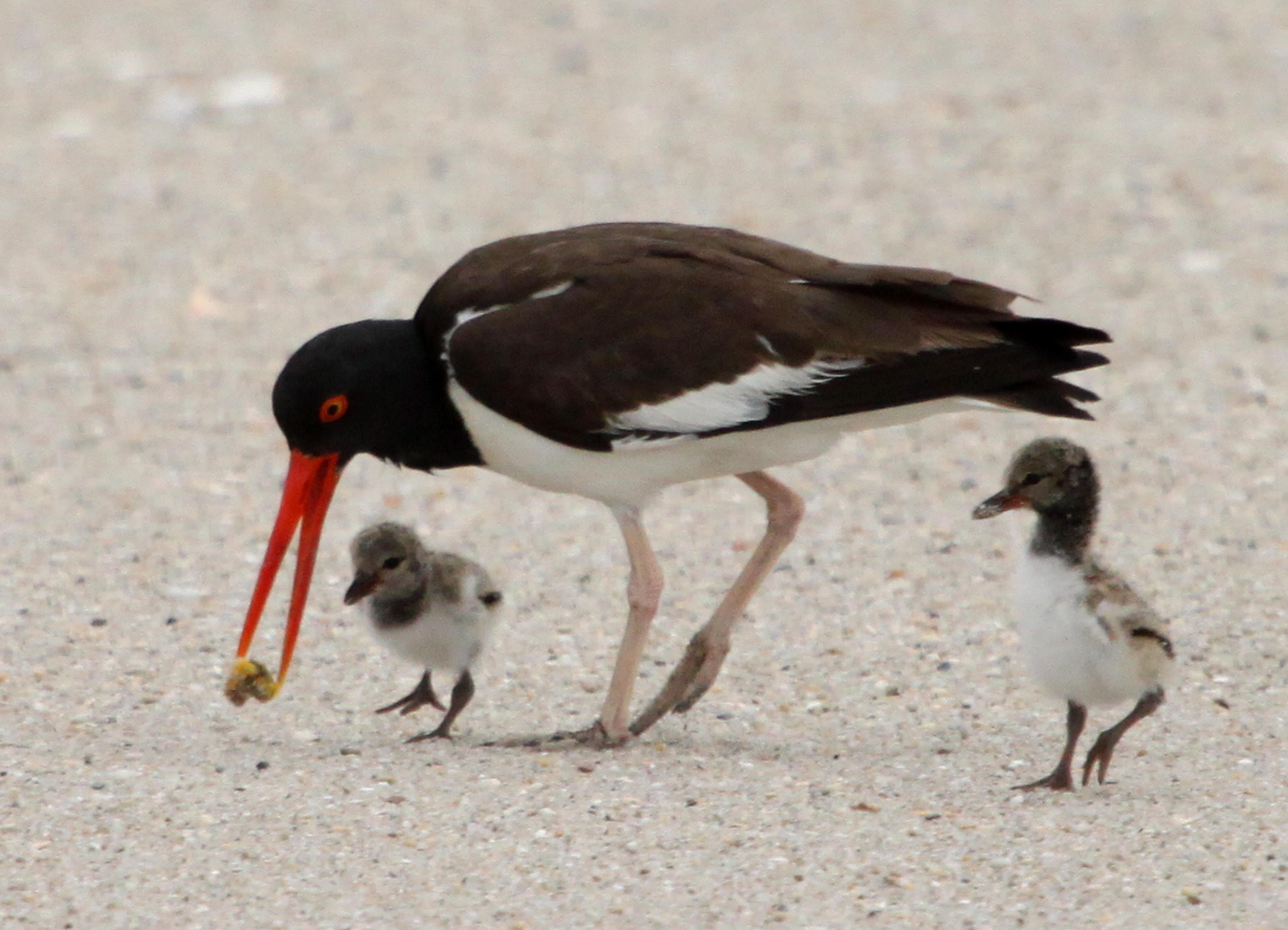
This striking shorebird has black and white plumage, a long bright orange bill, and yellow eyes with a red orbital ring. It measures 17 to 21 inches.
- Region of Habitat: Coastal areas of the eastern U.S., the Gulf of Mexico, and parts of Central and South America.
- Scientific Name:Haematopus palliatus
- Feeding Habits: Uses its strong bill to pry open mollusks, particularly oysters and clams.
- What Sound They Make: Loud, whistling “wheep-wheep” calls, especially during flight or alarm.
Fun Fact:
They sometimes stab shellfish before they can fully close their shells. Pairs perform synchronized calling and flight displays during courtship.
15. American Dipper
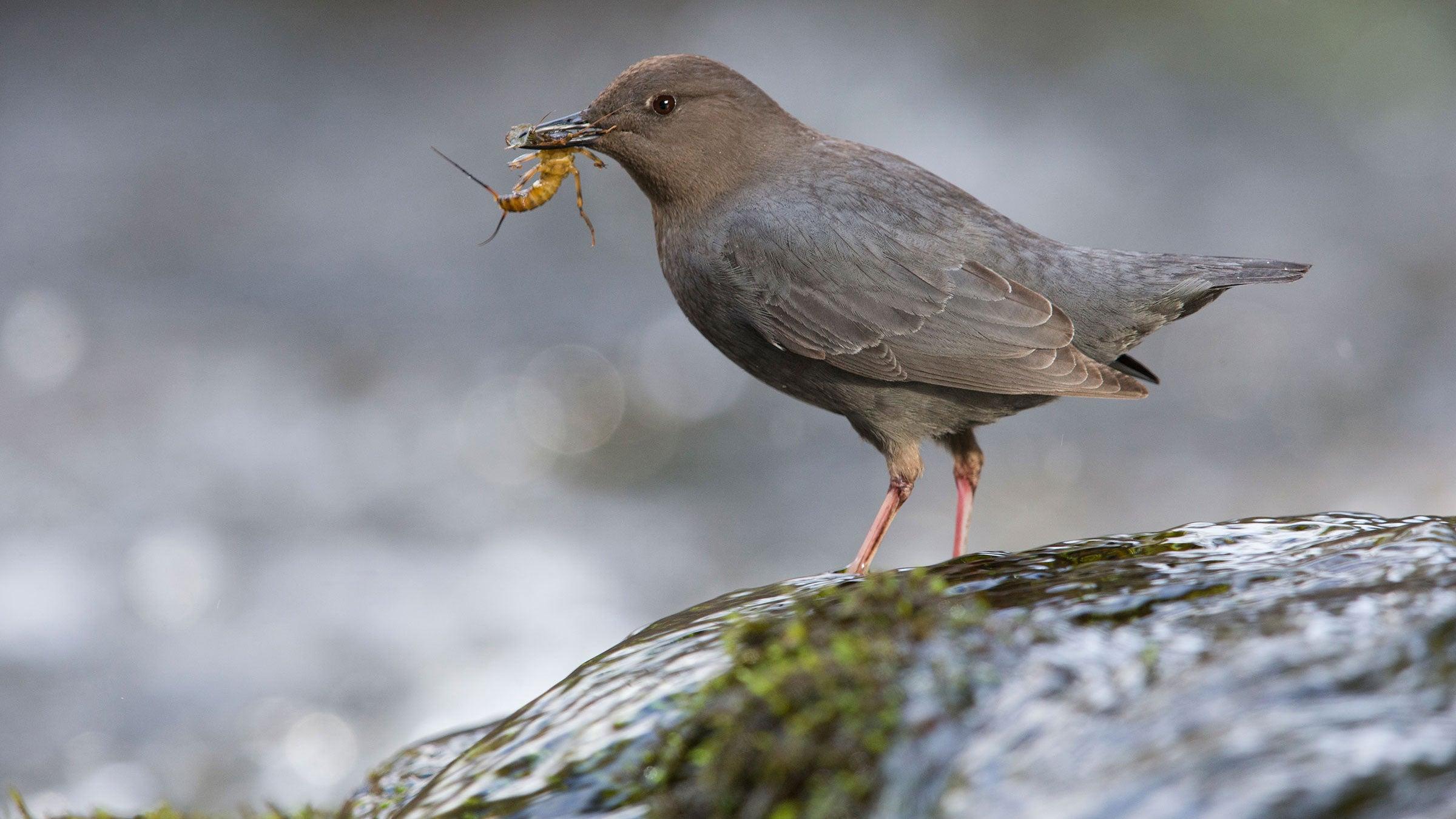
A round-bodied, short-tailed songbird about 7 inches long, with slate-gray plumage and white eyelids that flash when it blinks.
It often bobs or “dips” along fast-moving streams.
- Region of Habitat: Mountainous streams and rivers in western North America.
- Scientific Name:Cinclus mexicanus
- Feeding Habits: Feeds underwater on aquatic insects, larvae, and small fish; walks along streambeds using its wings for balance.
- What Sound They Make: High-pitched, metallic trills often heard over the sound of rushing water.
Fun Fact:
The American Dipper has an extra eyelid (nictitating membrane) and nasal flaps to see and breathe underwater. Thanks to its dense feathers and high metabolism, it can survive in freezing streams.
16. American Pipit
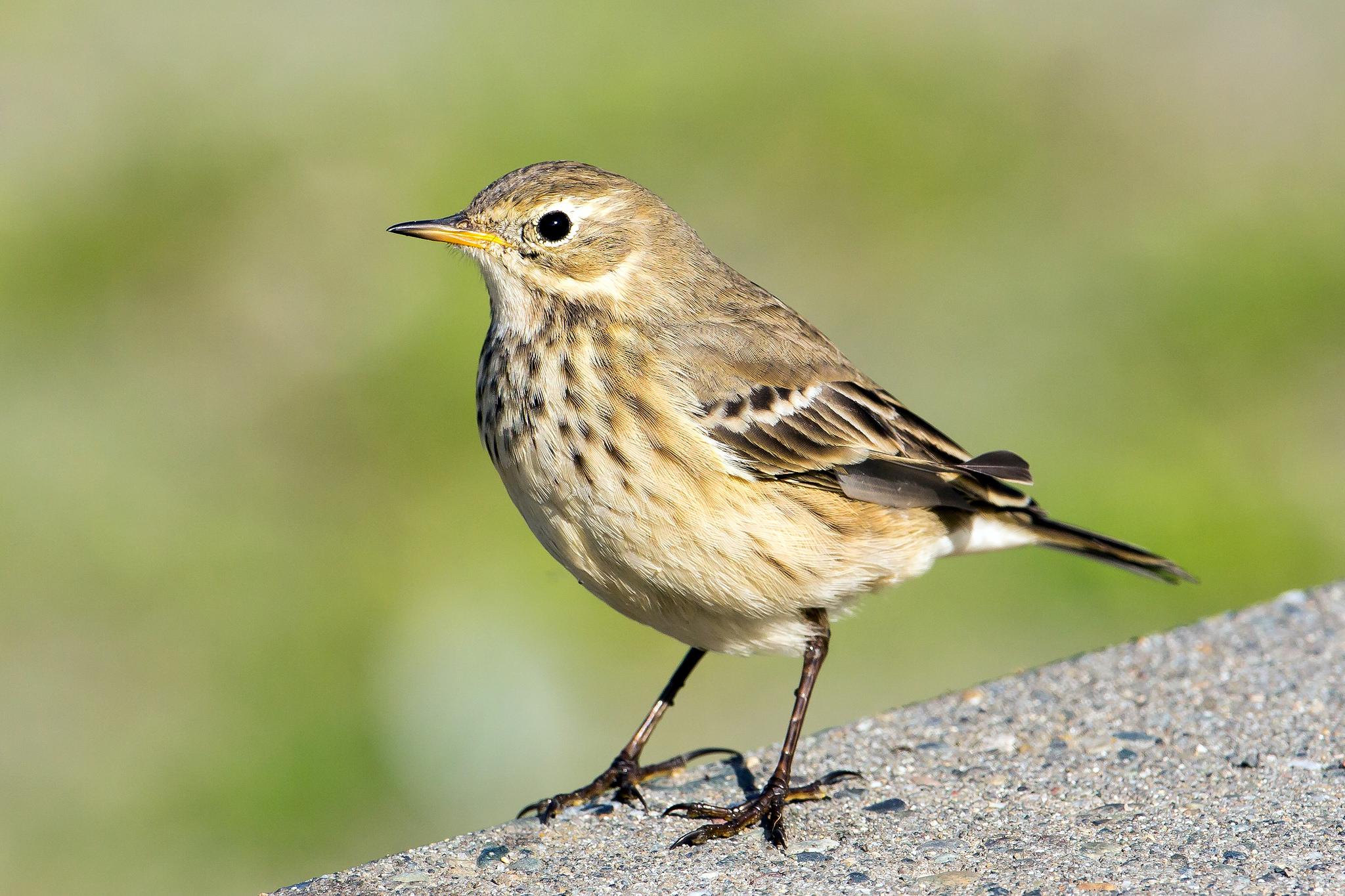
This slender, brownish songbird with streaked underparts and a long tail measures about 6 to 7 inches.
It walks rather than hops and frequently pumps its tail while foraging.
- Region of Habitat: Breeds in the Arctic and alpine tundra; winters in open fields, shorelines, and farmlands across North America.
- Scientific Name:Anthus rubescens
- Feeding Habits: Feeds on insects and seeds by walking across the ground and probing soil.
- What Sound They Make: High-pitched, whistled “pip-pip” call, often given in flight.
Fun Fact:
The American Pipit was once known as the “Water Pipit” until taxonomic revisions separated populations. It’s one of the few songbirds that adapted to nesting in alpine and Arctic tundra.
17. American Three-toed Woodpecker
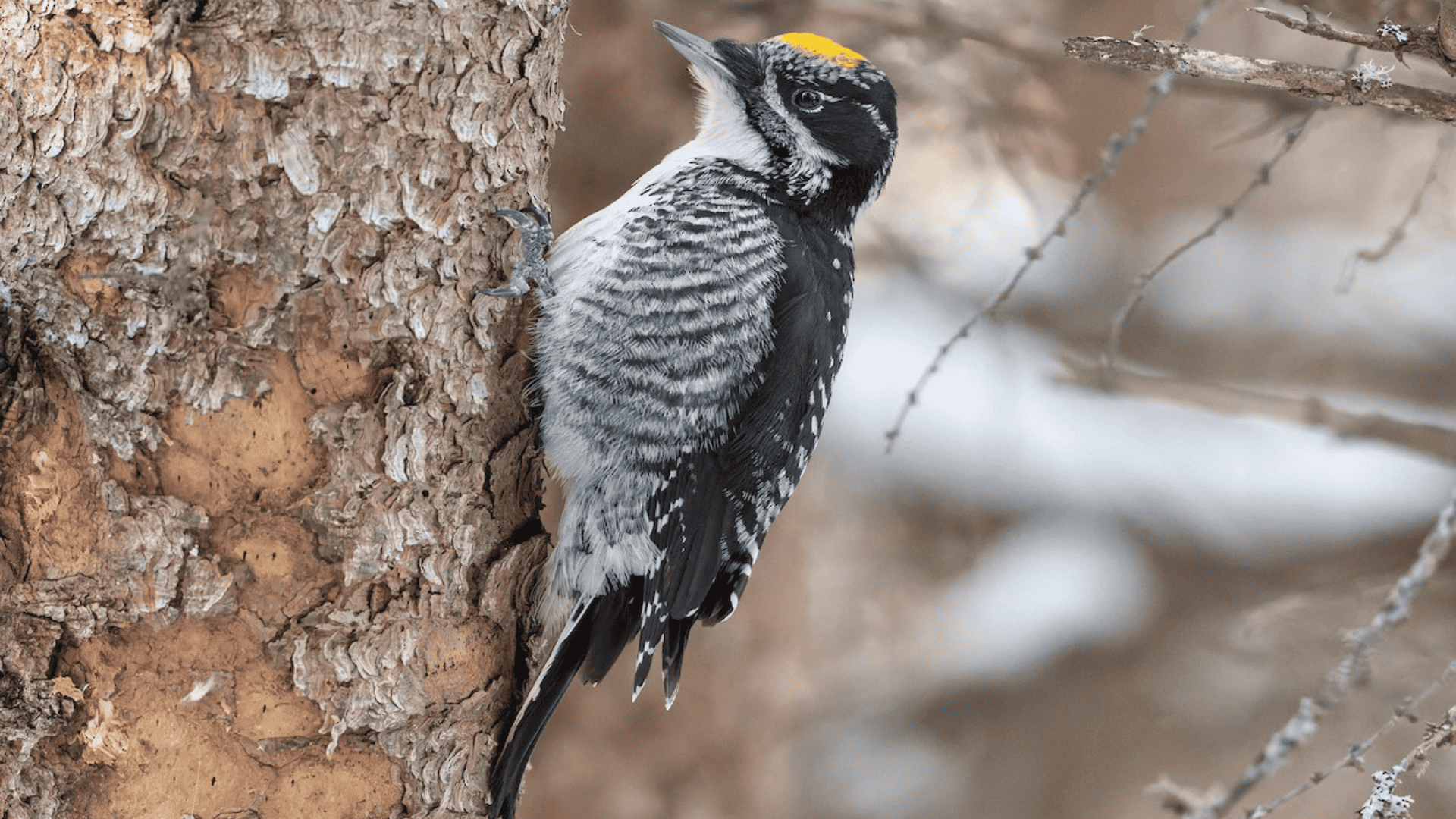
This small woodpecker measures around 8.5 to 9 inches. It has black and white plumage with a barred back and a yellow crown patch on males.
Uniquely, it has only three toes instead of four.
- Region of Habitat: Found in boreal forests of Canada, Alaska, and the northern U.S., often in coniferous woodlands.
- Scientific Name:Picoides dorsalis
- Feeding Habits: Feeds on wood-boring beetle larvae and other insects found under tree bark.
- What Sound They Make: A sharp “pik” call and slow, deliberate drumming.
Fun Fact:
It can flake bark off trees in long strips, revealing insect galleries underneath. It prefers recently burned forests, where beetle populations explode after fires.
18. Azure Kingfisher
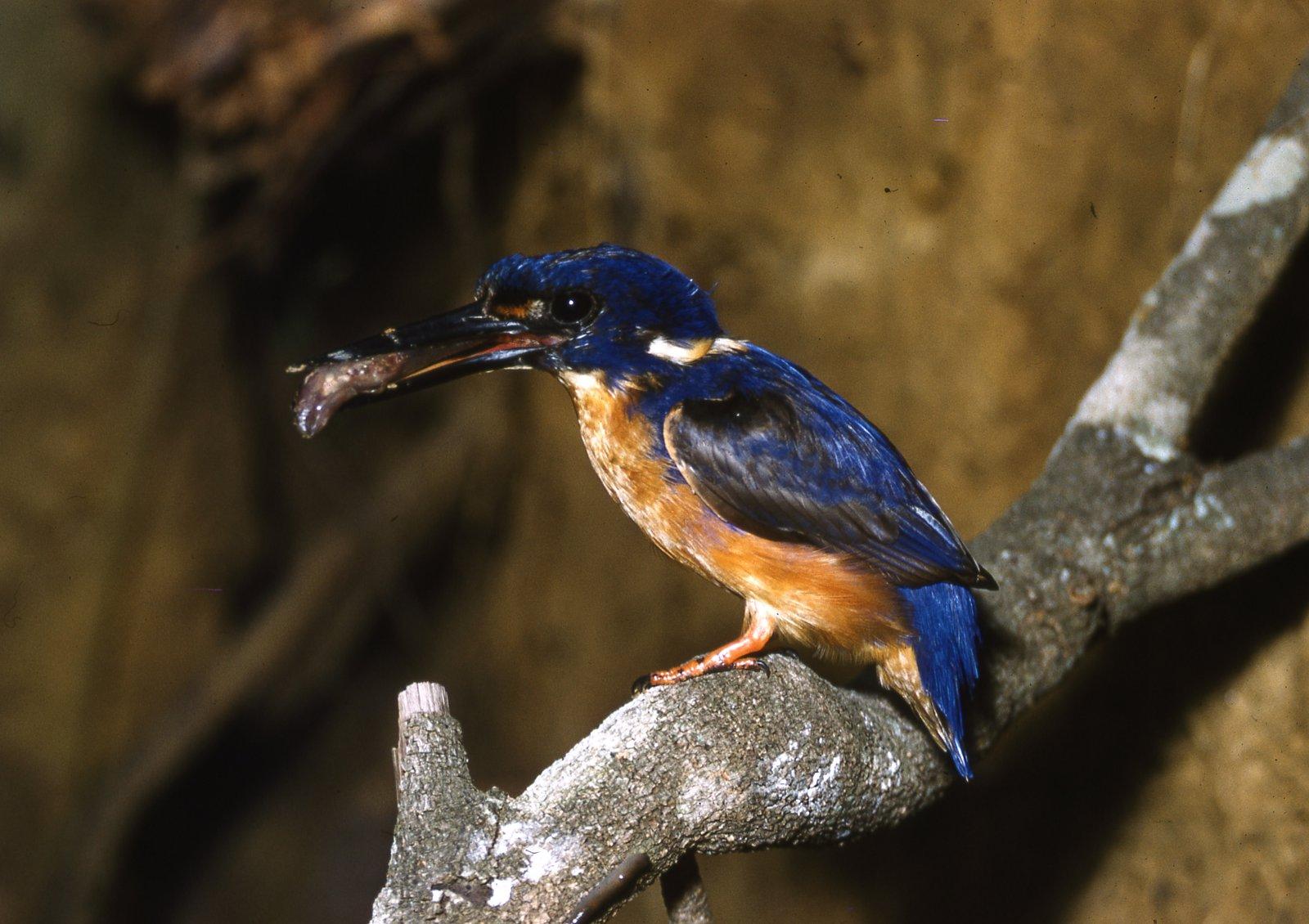
A small, dazzling bird measuring 6.5 to 7.5 inches, with vivid blue upperparts, orange underparts, and a white throat.
It has a short tail and long bill, ideal for catching fish.
- Region of Habitat: Native to Australia and Tasmania, often near freshwater rivers, streams, and mangroves.
- Scientific Name:Ceyx azureus
- Feeding Habits: Hunts small fish, insects, and aquatic invertebrates by diving from low perches.
- What Sound They Make: High-pitched “tsee-tsee” or sharp squeaking calls, often in flight.
Fun Fact:
They nest in burrows dug into stream banks, laying their eggs deep inside tunnels. Despite their bright color, they can be hard to spot when perched silently near water.
19. Arctic Tern
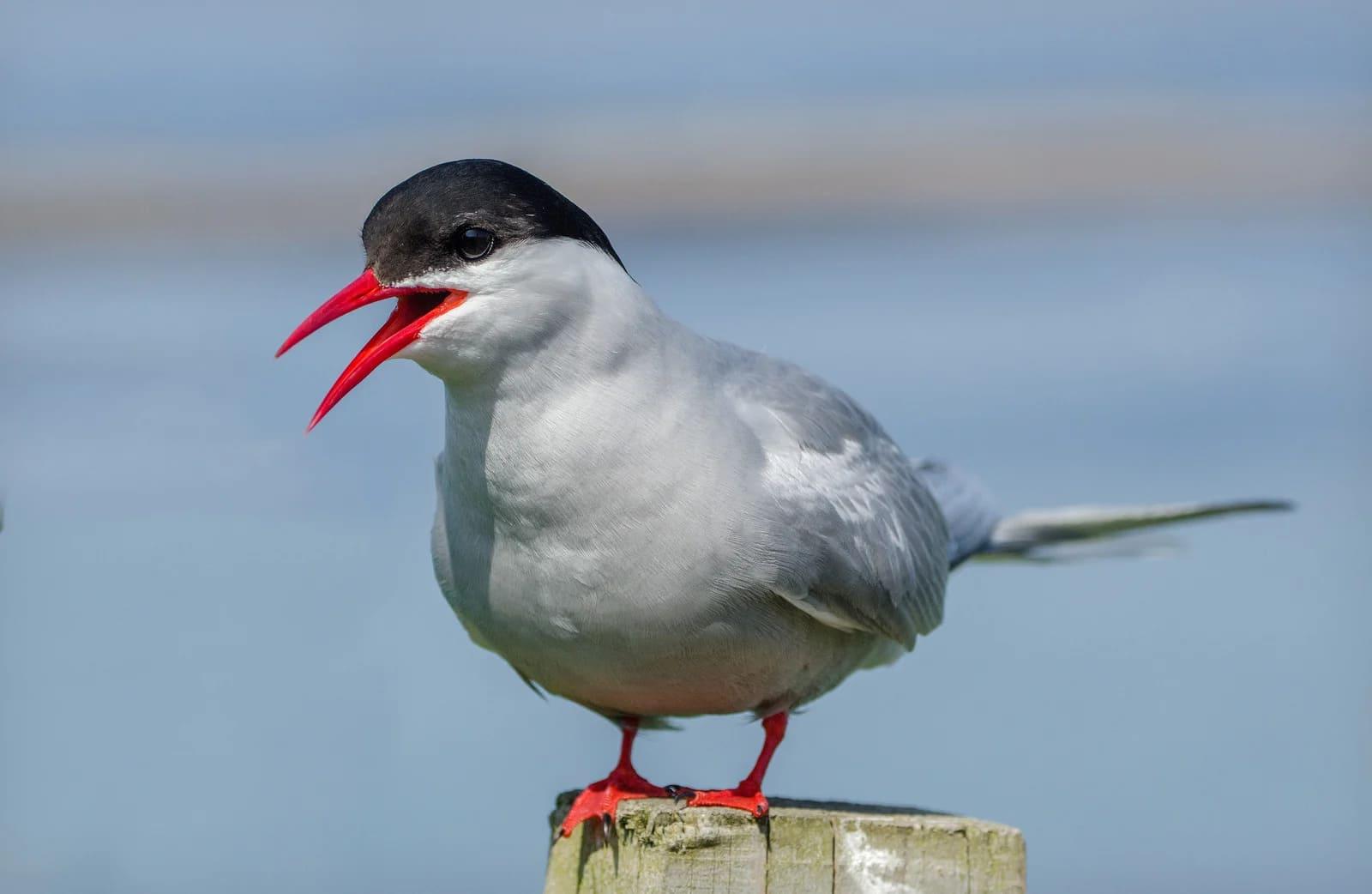
This graceful seabird is medium-sized (11 to 15 inches), with white plumage, grayish wings, a black cap, and a long forked tail.
It has a red bill and feet and is known for its aerial agility.
- Region of Habitat: Breeds in Arctic and sub-Arctic areas and migrates to the Antarctic, completing the longest migration of any bird.
- Scientific Name:Sterna paradisaea
- Feeding Habits: It plunges into the sea for fish and crustaceans; it also snatches prey from the water’s surface.
- What Sound They Make: Sharp, rasping “kee-ik” or “krree” calls, often made in flight or alarm.
Fun Fact:
Arctic Terns travel over 44,000 miles annually from pole to pole. They see more daylight than any other creature, experiencing two summers per year.
20. Albatross
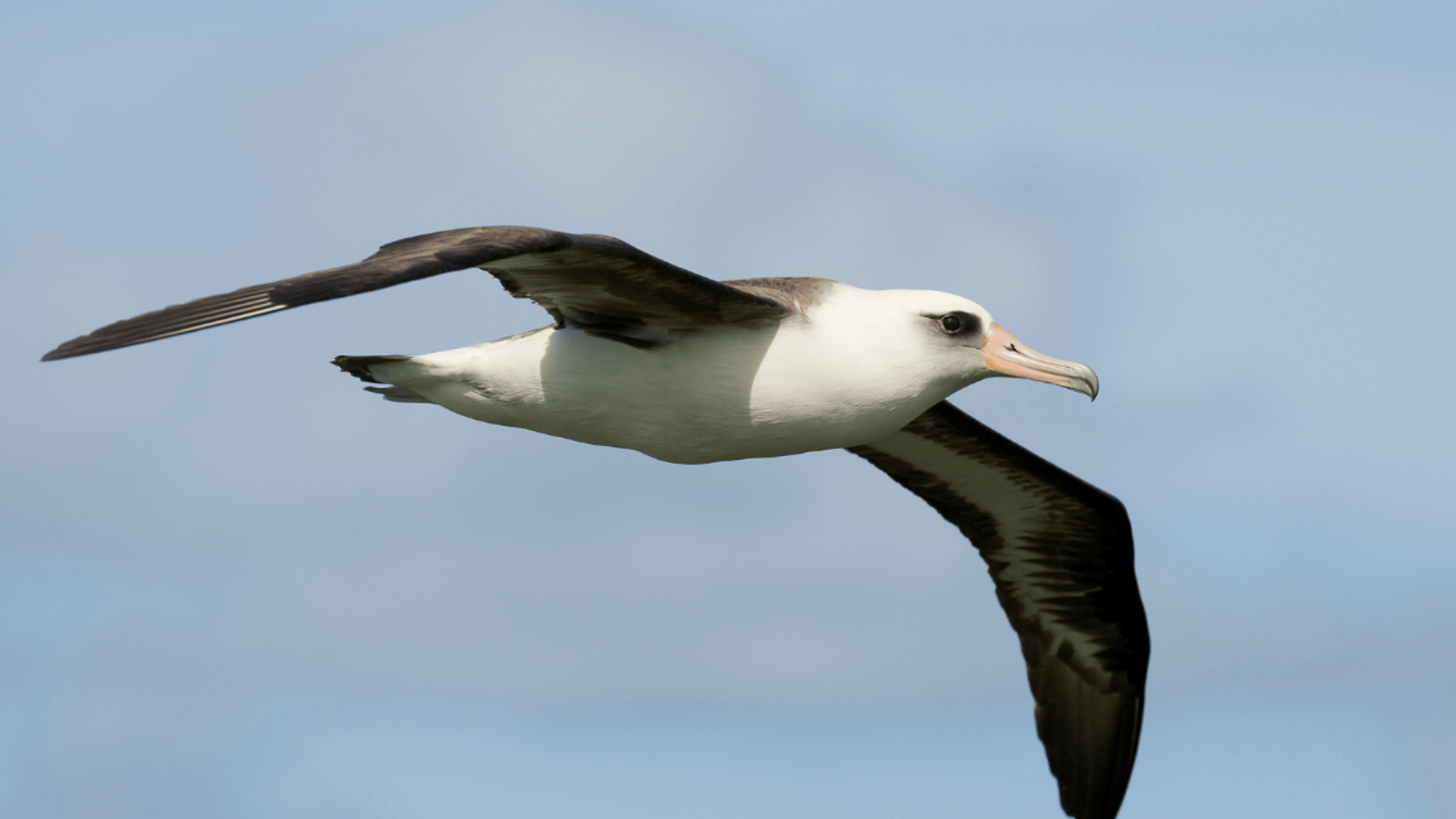
One of the largest flying birds, with wingspans reaching over 11 feet in some species.
Albatrosses have long, narrow wings, hooked bills, and predominantly white or gray plumage, depending on the species.
- Region of Habitat: Open oceans of the Southern Hemisphere and North Pacific; comes to land only to breed.
- Scientific Name:Diomedeidae (family name for all albatrosses)
- Feeding Habits: Feeds on squid, fish, and krill, scavenging on the ocean surface and sometimes diving.
- What Sound They Make: Clacking bills, moans, and whines used in courtship; most vocal on land.
Fun Fact:
Albatrosses can glide for hours without flapping their wings. They mate for life and return to the same nesting spot every few years.
21. Atlantic Puffin
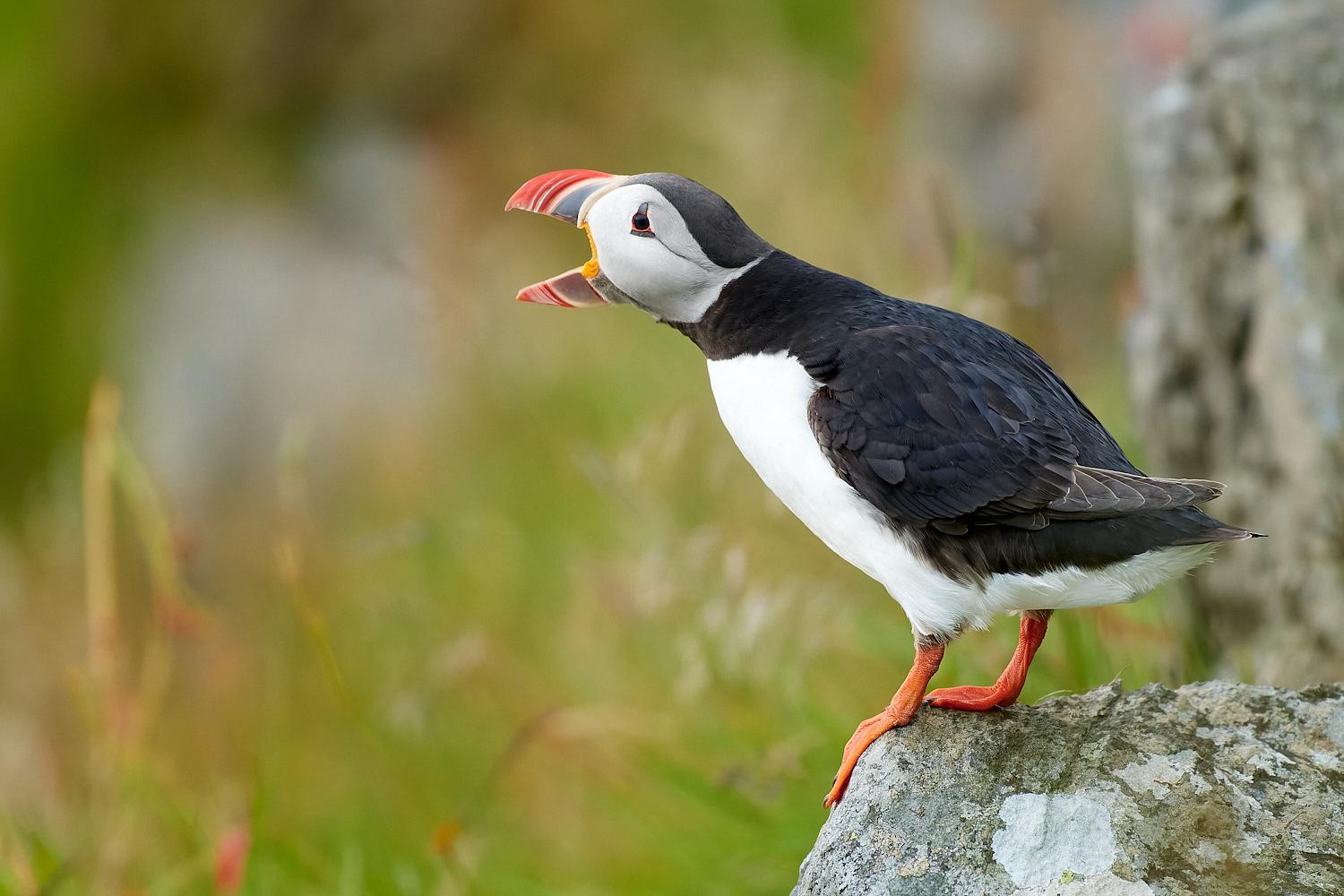
A small seabird with a chunky body (10 inches), black upperparts, white belly, and a colorful, triangular bill.
Often nicknamed the “sea parrot” for its appearance.
- Region of Habitat: Found in the North Atlantic, breeding on rocky cliffs and islands in Canada, Iceland, and northern Europe.
- Scientific Name:Fratercula arctica
- Feeding Habits: Dives to catch small fish like herring and sand eels; uses wings to “fly” underwater.
- What Sound They Make: Low growling or grunting noises in burrows; generally silent at sea
Fun Fact:
Puffins can carry multiple fish in their bills thanks to specialized spines on their tongues. They dig burrows on cliffs and use them as nesting chambers during breeding season.
More Birds with “A”
22. Allen’s Hummingbird
23. Abyssinian Roller
24. Acorn Woodpecker
25. Adelie Penguin
26. African Grey Parrot
27. African Fish Eagle
28. Andean Condor
29. Andean Cock-of-the-rock
30. Ash-throated Flycatcher
31. Asian Koel
32. Asian Paradise Flycatcher
33. Australian Magpie
34. Australian King Parrot
35. Australian Pelican
36. Azulet Hummingbird
37. Azulet Eagle
38. Azulet Owl
39. Azulet Puffin
40. Abdim’s Stork
41. Abyssinian Catbird
42. Abyssinian Ground Hornbill
43. Abyssinian Owl
44. Academy Eagle
45. Acacia Tit
46. Acridotheres Myna
47. Adelaide Rosella
48. Adjutant Stork
49. African Babbler
50. African Barred Owlet
51. African Black Duck
52. African Blue Flycatcher
53. African Broadbill
54. African Cuckoo
55. African Darter
56. African Emerald Cuckoo
57. African Finfoot
58. African Firefinch
59. African Fish Eagle
60. African Goshawk
61. African Gray Hornbill
62. African Green Pigeon
63. African Grey Parrot
64. African Harrier-Hawk
65. African Hawk-Eagle
66. African Hoopoe
67. African Jacana
68. African Olive Pigeon
69. African Openbill
70. African Palm Swift
71. African Paradise Flycatcher
72. African Pygmy Goose
73. African Quailfinch
74. African Rock Pipit
75. African Sacred Ibis
76. African Scops Owl
77. African Silverbill
78. African Skimmer
79. African Snipe
80. African Spoonbill
81. African Swamphen
82. African Thrush
83. African Wood Owl
84. Agami Heron
85. Agulhas Long-billed Lark
86. Ainsley’s Bulbul
87. Aizu Thrush
88. Akiapolaau
89. Akun Eagle-Owl
90. Alagoas Antwren
91. Alagoas Curassow
92. Alberti’s Lark
93. Albino Cockatiel
94. Aldabra Brush-Warbler
95. Alder Flycatcher
96. Aleutian Cackling Goose
97. Alexander’s Swift
98. Alexandrine Parakeet
99. Alfredi’s Pitta
100. Algerian Nuthatch
101. Alice’s Thrush
102. Allen’s Gallinule
103. Allen’s Woodpecker
104. Allpahuayo Antbird
105. Alpine Accentor
106. Alpine Chough
107. Alpine Swift
108. Altamira Oriole
109. Altai Snowcock
110. Altorio’s Brushfinch
111. Amazon Kingfisher
112. Amazonian Antpitta
113. Amazonian Barred Woodcreeper
114. Amazonian Inezia
115. Amazonian Motmot
116. Amazonian Parrotlet
117. Amazonian Umbrellabird
118. Amber Mountain Rock-Thrush
119. Amethyst Starling
120. Amethyst-throated Hummingbird
121. Amethyst-throated Sunangel
122. Amur Falcon
123. Amur Paradise Flycatcher
124. Anambra Sunbird
125. Anambra Waxbill
126. Anahuac Wren
127. Andean Duck
128. Andean Flicker
129. Andean Goose
130. Andean Guan
131. Andean Hillstar
132. Andean Lapwing
133. Andean Motmot
134. Andean Potoo
135. Andean Siskin
136. Andean Solitaire
137. Andean Swift
138. Andean Tinamou
139. Andean Tit-Spinetail
140. Andean Toucanet
141. Andean Woodcreeper
142. Andean Yellow-Finch
143. Angel Tern
144. Angola Cave Chat
145. Angola Lark
146. Angola Slaty Flycatcher
147. Anianiau
148. Anjouan Brush Warbler
149. Anjouan Scops Owl
150. Ankole Waxbill
151. Annobón White-eye
152. Antarctic Petrel
153. Antbird
154. Ant-eating Chat
155. Antillean Bullfinch
156. Antillean Crested Hummingbird
157. Antillean Euphonia
158. Antillean Mango
159. Antillean Nighthawk
160. Antillean Palm Swift
161. Antillean Siskin
162. Antipodean Albatross
163. Antipodes Island Parakeet
164. Apapane
165. Apical Flycatcher
166. Apollonia’s Sunbird
167. Appenzell Siskin
168. Arabian Babbler
169. Arabian Bustard
170. Arabian Golden Sparrow
171. Arabian Lark
172. Arabian Partridge
173. Arabian Scops Owl
174. Arabian Warbler
175. Aracari
176. Araripe Manakin
177. Arc Mountain Greenbul
178. Arctic Loon
179. Arctic Redpoll
180. Arctic Skua
181. Arequipa Ground Tyrant
182. Argentavis
183. Argentine Horned Owl
184. Argentina Rail
185. Arizona Woodpecker
186. Armenian Gull
187. Arnaud’s Weaver
188. Arrow-marked Babbler
189. Ash-breasted Antbird
190. Ash-breasted Sierra-Finch
191. Ash-capped Flycatcher
192. Ash-colored Tapaculo
193. Ash-crowned Sparrow-Lark
194. Ash-throated Crake
195. Ash-throated Warbler
196. Ashy Bulbul
197. Ashy Cisticola
198. Ashy Crowned Sparrow Lark
199. Ashy Drongo
200. Ashy Flycatcher
201. Ashy Minivet
202. Ashy Prinia
203. Ashy Storm-Petrel
204. Ashy Tailorbird
205. Ashy Thrush
206. Asian Brown Flycatcher
207. Asian Buzzard
208. Asian Dowitcher
209. Asian Emerald Cuckoo
210. Asian Fairy-bluebird
211. Asian Glossy Starling
212. Asian House Martin
213. Asian Openbill
214. Asian Palm Swift
215. Asian Pied Starling
216. Asian Rosy Finch
217. Asian Short-toed Lark
218. Asian Stubtail
219. Asian Woolly-necked Stork
220. Assam Laughingthrush
221. Assam Treecreeper
222. Assam Warbler
223. Assumption Rail
224. Asthenes Dorbignyi
225. Atacama Desert Finch
226. Atitlán Grebe
227. Atlantic Canary
228. Atlantic Petrel
229. Atlantic Royal Flycatcher
230. Atlapetes Brunneinucha
231. Atlas Flycatcher
232. Atlas Horned Lark
233. Atlas Wheatear
234. Atoyac Rail
235. Atuen Antshrike
236. Aubin’s Sunbird
237. Auckland Island Shag
238. Auckland Island Teal
239. Auckland Rail
240. Audouin’s Gull
241. Audubon’s Oriole
242. Audubon’s Shearwater
243. Augur Buzzard
244. Auk
245. Aung San Dove
246. Aurora Parrot
247. Aurora Tanager
248. Australian Boobook
249. Australian Brush-turkey
250. Australian Bustard
251. Australian Figbird
252. Australian Gannet
253. Australian Golden Whistler
254. Australian Hobby
255. Australian Ibis
256. Australian Kookaburra
257. Australian Logrunner
258. Australian Masked Owl
259. Australian Owlet-nightjar
260. Australian Pied Cormorant
261. Australian Pipit
262. Australian Pratincole
263. Australian Raven
264. Australian Reed Warbler
265. Australian Ringneck
266. Australian Shelduck
267. Australian Swiftlet
268. Australian Treecreeper
269. Australian White Ibis
270. Australian Wood Duck
271. Avadavat
272. Avianus Shrike
273. Ayacucho Antpitta
274. Ayeyarwady Bulbul
275. Azara’s Spinetail
276. Aztec Antthrush
277. Aztec Rail
278. Azure Dollarbird
279. Azure Gallinule
280. Azure Jay
281. Azure Tit
282. Azure-crowned Hummingbird
283. Azure-hooded Jay
284. Azure-naped Jay
285. Azure-rumped Tanager
286. Azure-shouldered Tanager
287. Azure-thighed Treecreeper
288. Azure-winged Magpie
289. Azurite Kingfisher
290. Azuero Dove
291. Azuero Parakeet
292. Azuero Wren
293. Azuero Yellowthroat
294. Azulet Flycatcher
295. Azulet Warbler
296. Azulet Tanager
297. Azulet Vireo
298. Azulet Woodpecker
299. Azulet Finch
300. Azulet Swift
301. Azulet Hummingbird
302. Azulet Pipit
303. Azulet Antbird
304. Azulet Parrotlet
305. Azulet Starling
306. Azulet Gnatcatcher
307. Azulet Owl
308. Azulet Cuckoo
309. Azulet Chat
310. Azulet Thrush
311. Azulet Seedeater
312. Azulet Babbler
313. Azulet Sunbird
314. Azulet Nighthawk
315. Azulet Flycatcher-Tanager
316. Azulet Treepie
317. Azulet Shrike
318. Azulet Greenbul
319. Azulet Roller
320. Azulet Warbling Finch
321. Azulet Monarch
322. Azulet Woodcreeper
323. Azulet Cisticola
324. Azulet Puffbird
325. Azulet Jacamar
326. Azulet Barbet
327. Azulet Broadbill
328. Azulet Tody
329. Azulet Motmot
330. Azulet Cotinga
331. Azulet Manakin
332. Azulet Antshrike
333. Azulet Tapaculo
334. Azulet Tyrannulet
335. Azulet Vanga
336. Azulet Trogon
337. Azulet Honeyguide
338. Azulet Drongo
339. Azulet Oriole
340. Azulet Lark
341. Azulet Bristlefront
342. Azulet Wagtail
343. Azulet Bowerbird
344. Azulet Fairywren
345. Azulet Whistler
346. Azulet Fantail
347. Azulet Sittella
348. Azulet Pardalote
349. Azulet Thornbill
350. Azulet Boobook
351. Azulet Gerygone
352. Azulet Treecreeper
353. Azulet Honeyeater
354. Azulet Grasswren
355. Azulet Lyrebird
356. Azulet Scrubwren
357. Azulet Snipe
358. Azulet Sandpiper
359. Azulet Bunting
360. Azulet Munia
361. Azulet Weaver
362. Azulet Tern
363. Azulet Gull
364. Azulet Petrel
365. Azulet Shearwater
366. Azulet Prion
367. Azulet Noddy
368. Azulet Skimmer
369. Azulet Booby
370. Azulet Gannet
371. Azulet Frigatebird
372. Azulet Cormorant
373. Azulet Anhinga
374. Azulet Egret
375. Azulet Heron
376. Azulet Bittern
377. Azulet Ibis
378. Azulet Spoonbill
379. Azulet Flamingo
380. Azulet Stork
381. Azulet Crane
382. Azulet Rail
383. Azulet Gallinule
384. Azulet Coot
385. Azulet Bustard
386. Azulet Serpent Eagle
387. Azulet Harrier
388. Azulet Sparrowhawk
389. Azulet Goshawk
390. Azulet Kite
391. Azulet Hawk
392. Azulet Falcon
393. Azulet Kestrel
394. Azulet Caracara
395. Azulet Owlet
396. Azulet Nightjar
397. Azulet Frogmouth
398. Azulet Oilbird
399. Azulet Swift
400. Azulet Kingfisher
401. Azulet Bee-eater
402. Azulet Hoopoe
403. Azulet Hornbill
404. Azulet Trogon
405. Azulet Woodpecker
406. Azulet Barbet
407. Azulet Toucan
408. Azulet Puffin
409. Azulet Auk
410. Azulet Murre
411. Azulet Guillemot
412. Azulet Razorbill
413. Azulet Dovekie
414. Azulet Pigeon
415. Azulet Dove
416. Azulet Parrot
417. Azulet Parakeet
418. Azulet Macaw
419. Azulet Lovebird
420. Azulet Conure
421. Azulet Lorikeet
422. Azulet Cockatoo
423. Azulet Cockatiel
424. Azulet Budgerigar
425. Azulet Tanager
426. Azulet Finch
427. Azulet Grosbeak
428. Azulet Sparrow
429. Azulet Towhee
430. Azulet Junco
431. Azulet Warbler
432. Azulet Gnatcatcher
433. Azulet Vireo
434. Azulet Babbler
435. Azulet Thrush
436. Azulet Solitaire
437. Azulet Starling
438. Azulet Myna
439. Azulet Robin
440. Azulet Chat
441. Azulet Wheatear
442. Azulet Redstart
443. Azulet Flycatcher
444. Azulet Pipit
445. Azulet Lark
446. Azulet Swallow
447. Azulet Martin
448. Azulet Wren
449. Azulet Creeper
450. Azulet Nuthatch
451. Azulet Tit
452. Azulet Chickadee
453. Azulet Penduline Tit
454. Azulet Long-tailed Tit
455. Azulet Bush Warbler
456. Azulet Leaf Warbler
457. Azulet Cuckoo
458. Azulet Coucal
459. Azulet Roadrunner
460. Azulet Ani
461. Azulet Turaco
462. Azulet Mousebird
463. Azulet Trogon
464. Azulet Sunbird
465. Azulet Flowerpecker
466. Azulet Spiderhunter
467. Azulet Sugarbird
468. Azulet White-eye
469. Azulet Berrypecker
470. Azulet Bellbird
471. Azulet Cotingas
472. Azulet Plantcutter
473. Azulet Oxpecker
474. Azulet Drongo
475. Azulet Monarch
476. Azulet Shrike
477. Azulet Jay
478. Azulet Magpie
479. Azulet Crow
480. Azulet Raven
481. Azulet Treepie
482. Azulet Chough
483. Azulet Grackle
484. Azulet Oriole
485. Azulet Blackbird
Summing Up
Concluding our expedition through the mesmerising world of birds that begin with “A,” hopefully, you’ve gained a deeper appreciation for these diverse avian species.
From the Arctic to the Amazon, these remarkable creatures demonstrate nature’s incredible adaptations across different habitats and ecosystems.
The scientific classifications, feeding habits, and distinctive calls we’ve explored reveal the complex relationships between these birds and their environments.
Remember that each species, no matter how common or rare, plays a vital role in maintaining ecological balance.
If you’re interested in more informative animal and wildlife content, feel free to click here and explore other blogs that you might enjoy!




